Table of Contents
British Seabirds are an iconic piece of the Great British Coastline, with some species seen all year round. In contrast, others are migratory and visit only during the spring, breed during the summer, and leave for warmer climates in the autumn.
The British Coastline is a vital breeding habitat for Sea birds, supporting species that migrate from as far away as South America and Africa. In addition, the British Coastline has a range of geographical features ideal for supporting numerous bird colonies, including rocky cliffsides and sand dunes on smaller islands.
Divers
Black throated diver
A large aquatic bird characterised by a black throat, a grey head and neck, and a black and white back. In the winter, its plumage turns much paler. It averages 66 cm in length, with a 1.2 m wingspan and a dagger-like bill.
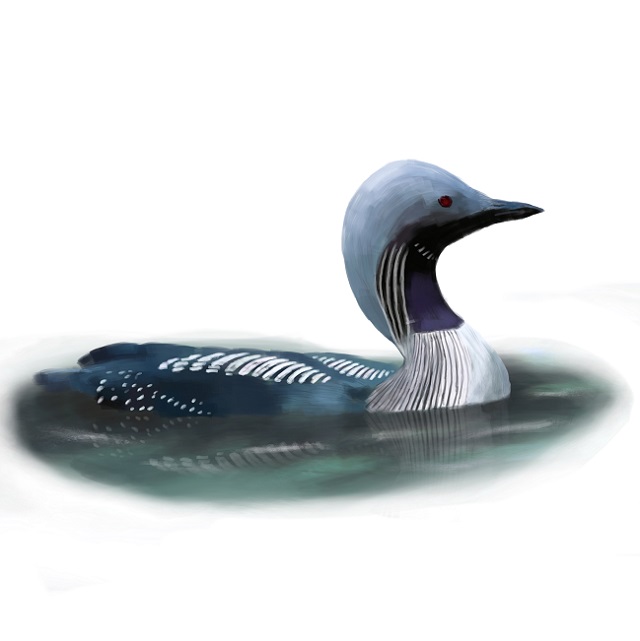
| Latin Name | Gavia arctica |
| Diet | Black throated divers feed mainly on fish, molluscs and crustaceans. |
| Best time to see | December to February |
| Distribution | Found in northern Scotland during summer, but present around much of the UK coastline during winter. |
| Habitat | Black throated divers prefer sheltered inshore waters, although they often move to lochs and inland reservoirs to breed. |
| Migrant/Resident | Resident breeder and winter visitor. |
| Interesting fact | Diving to depths of up to 6 metres, these birds have an 80% success rate when it comes to finding food. |
Red throated diver
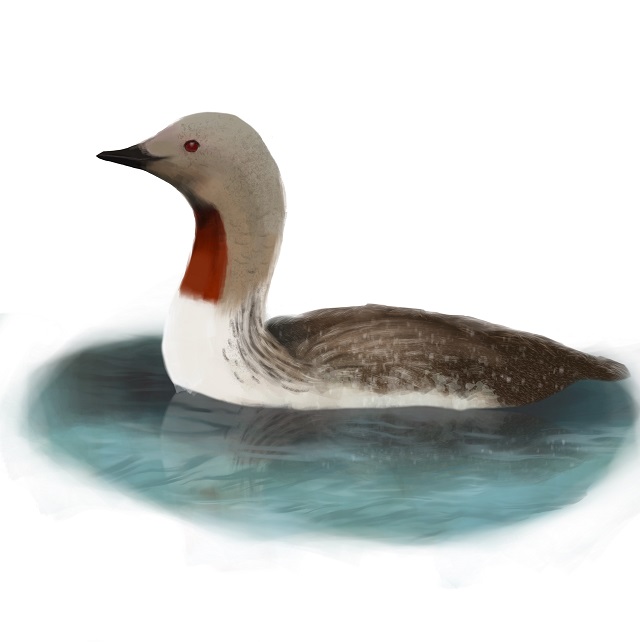
| Latin Name | Gavia stellata |
| Diet | Primarily a fish-eater, although molluscs and crustaceans may also be taken. |
| Best time to see | December to February. |
| Distribution | Found throughout the UK coastline during winter, with populations breeding in north-west Scotland during summer. |
| Habitat | Red throated divers are mostly seen in inshore coastal waters, but prefer to breed on small pools and lochs. |
| Migrant/Resident | Resident breeder and winter visitor |
| Interesting fact | In late summer, red throated divers undergo a complete wing moult, where they lose all their flight feathers at once and become unable to fly for several weeks. |
Grebes
Little grebe
True to its name, the little grebe is the smallest member of the grebe family, measuring 27 cm in length, with a wingspan of 42 cm. Its plumage is dark brown, but rufous-coloured patches appear around its cheeks and neck during summer
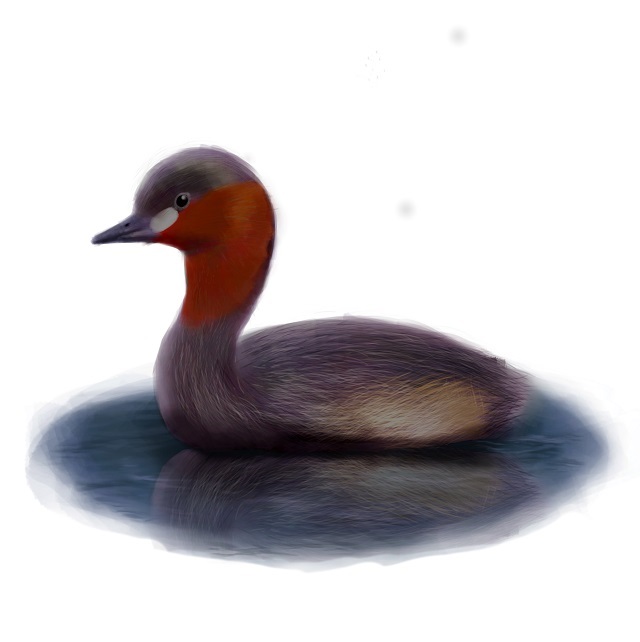
| Latin Name | Tachybaptus ruficollis |
| Diet | Mainly fish and aquatic invertebrates. |
| Best time to see | December to February. |
| Distribution | Found in lowland areas throughout the UK. |
| Habitat | Little grebes live in slow-moving waterways, ponds and lakes, usually where there is lush vegetation. |
| Migrant/Resident | Resident breeder and winter visitor. |
| Interesting fact | For such a small bird, the little grebe can be surprisingly loud, producing a distinctive trill that is similar to a horse whinnying. |
Great crested grebe
Great crested grebes measure around 47 cm in length, with an 88 cm wingspan. This makes them the largest member of the grebe family. They can be identified by their white necks and dark backs, or by the large, colourful plumes that appear on their heads during the breeding season.
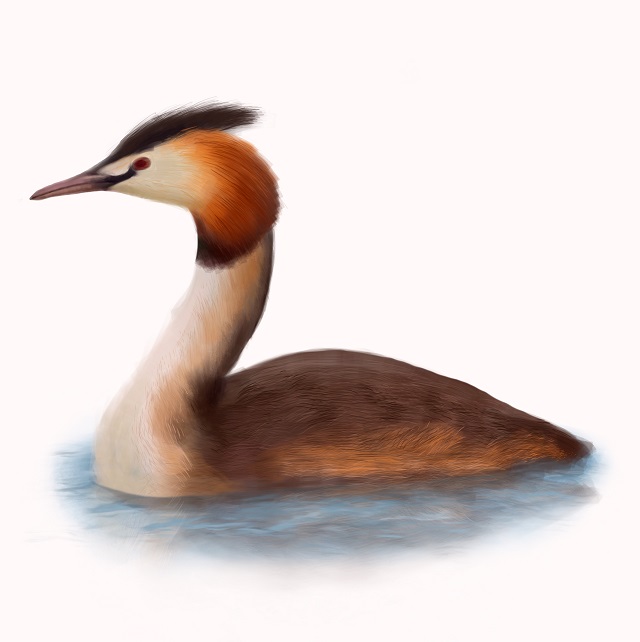
| Latin Name | Podiceps cristatus |
| Diet | Fish is their preferred food, but they will also feed on crustaceans and small amphibians. |
| Best time to see | December to February. |
| Distribution | Found mostly in southern Britain, in lowland regions. Further north, they appear more often during winter. |
| Habitat | Great crested grebes are commonly seen along the coast, but can also be found on lakes, reservoirs and rivers. |
| Migrant/Resident | Resident breeder and winter visitor. |
| Interesting fact | These birds are well-known for their elaborate courtship dances, where breeding pairs engage in synchronised performances on the water to maintain their bonds. |
Gannets
Northern gannet
The northern gannet is a large white seabird with a yellow head and prominent black wingtips. They average 90 cm in length, with a wingspan of 2 m. Their sharp beaks are large and tinged with blue.
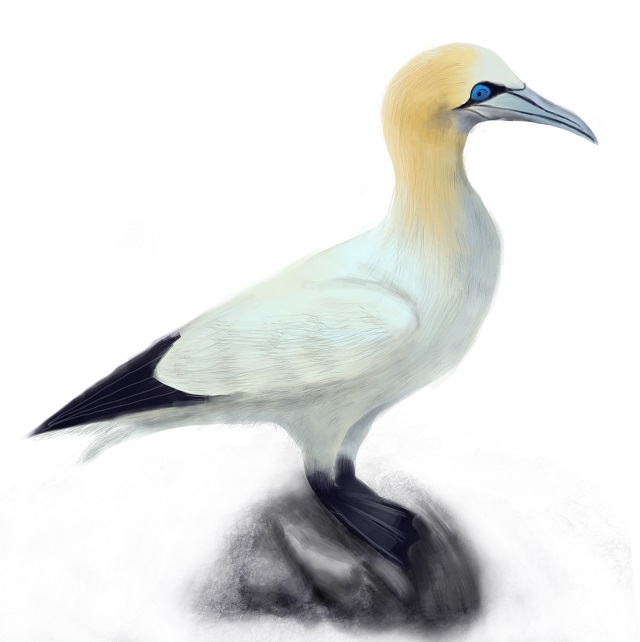
| Latin Name | Morus bassanus |
| Diet | Mainly fish, although squid may be taken opportunistically. |
| Best time to see | April to August. |
| Distribution | Found right around the UK coast, although nesting is more common in northerly regions. |
| Habitat | Coastal cliffs and offshore rocks are preferred as nesting sites. While fishing, northern gannets tend to stick close to the shore, occasionally moving further out. |
| Migrant/Resident | Breeding summer migrant. |
| Interesting fact | Northern gannets dive head-first into the water on the hunt for fish, sometimes hitting the water at over 60 mph. |
Auks
Common guillemot
Common guillemots have dark brown backs and white underbellies, with relatively long bills. Their average length is 40 cm and they have a wingspan of 67 cm.
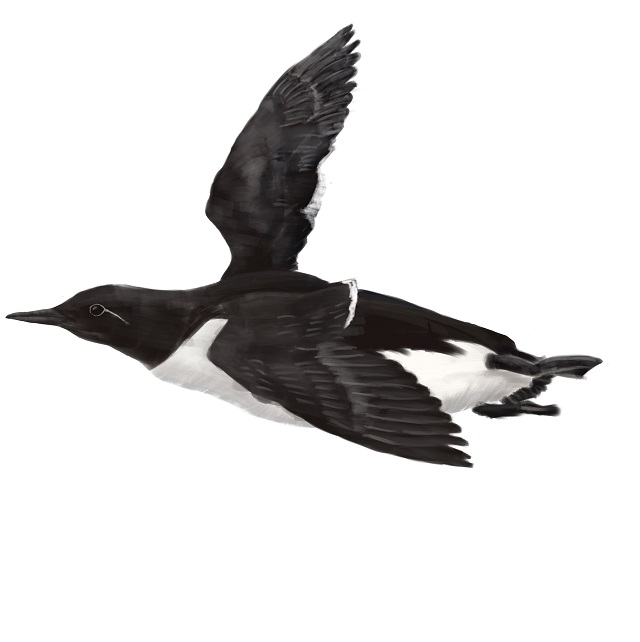
| Latin Name | Uria aalge |
| Diet | Primarily small fish such as sandeels, supplemented by molluscs and squid. |
| Best time to see | March to July. |
| Distribution | Most common in Scotland and Northern England, where breeding occurs in summer. In winter, common guillemots can be seen offshore around much of the British coast. |
| Habitat | Nesting usually occurs on high sea cliffs and rocky islands. |
| Migrant/Resident | Resident breeder and summer visitor. |
| Interesting fact | Common guillemot colonies are known as ‘loomeries’ and are renowned for their high nest densities, where as many as 40 birds will share just one square metre of cliff. |
Black guillemot
Black guillemots change appearance in relation to the season, with their summer plumage being black with white wing patches and their winter plumage being a mixture of white, grey and black. They average 31 cm in length, with 55 cm wingspans.

| Latin Name | Cepphus grylle |
| Diet | Small fish and molluscs. |
| Best time to see | May to August. |
| Distribution | Found on coasts in north-west Britain, particularly Scotland and Northern Ireland. |
| Habitat | Nests on cliffs and rocky islands, but can often be seen fishing in inshore waters. |
| Migrant/Resident | Resident breeder. |
| Interesting fact | Black guillemots will defend their nests aggressively, sometimes lunging at intruders with backs hunched and bills open. |
Razorbill
The razorbill is a medium-sized bird with a chunky, black bill. Its plumage is black on top and white below, and it measures around 40 cm in length, with a 66 cm wingspan. In winter, their faces turn white.

| Latin Name | Alca torda |
| Diet | Small fish such as sandeels and sprat. |
| Best time to see | Best time to see: March to July. |
| Distribution | Razorbills are found right around the UK coast, though they usually spend the winter in offshore waters. Breeding happens at established seabird colonies during summer. |
| Habitat | Fishing occurs in inshore waters, with nests being constructed on coastal cliffs. |
| Migrant/Resident | Resident breeder and summer visitor. |
| Interesting fact | Razorbill chicks fledge by taking a leap of faith from their clifftop nests into the water below. They almost always do this after sunset. |
Atlantic puffin
An unmistakeable bird, the Atlantic puffin has black and white plumage and a large, multicoloured beak. They are relatively small, averaging 27 cm in length, with 55 cm wingspans.
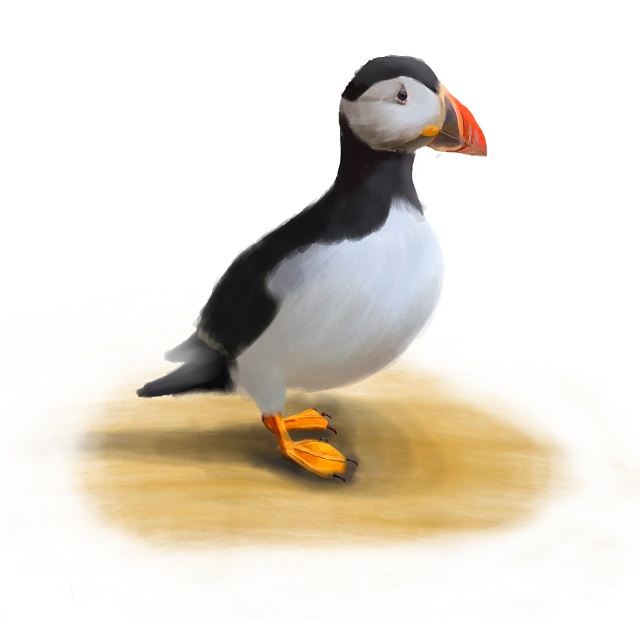
| Latin Name | Fratercula arctica |
| Diet | Small fish, particularly sandeels. |
| Best time to see | June to August. |
| Distribution | Puffins are found in scattered locations, primarily in eastern Scotland and England. They are also visitors to western coasts during summer. |
| Habitat | Nests on cliffs and remote islands. |
| Migrant/Resident | Resident breeder and summer visitor. |
| Interesting fact | Due to their comical appearance, Atlantic puffins are often known as ‘sea parrots’ or ‘the clowns of the ocean’. |
Cormorants
Great cormorant
Great cormorants are large, black birds with long necks. In the breeding season, adults develop white patches above their thighs. They measure around 88 cm in length, with 1.5 m wingspans.
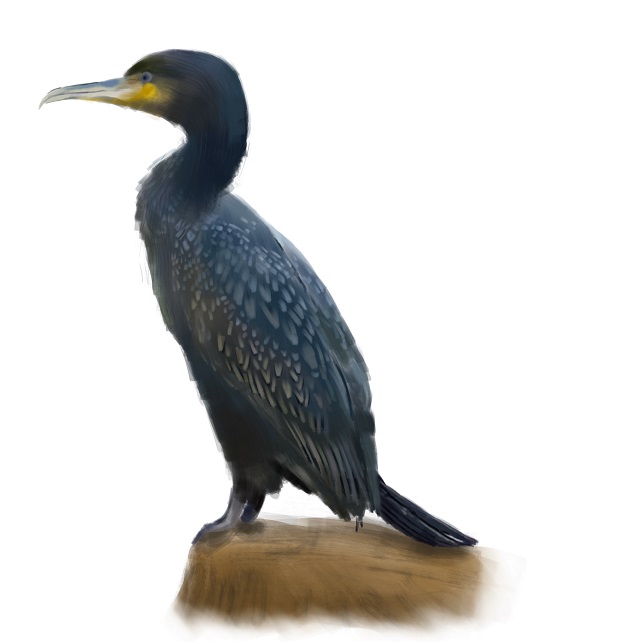
| Latin Name | Phalacrocorax carbo |
| Diet | Primarily fish. |
| Best time to see | December to February. |
| Distribution | Cormorants can be seen around the UK coastline. |
| Habitat | Rocky shores and estuaries are preferred, although they can also be found on inland lakes and rivers. |
| Migrant/Resident | Resident breeder. |
| Interesting fact | Great cormorants are adept at fishing, however they need to dry their feathers before being able to fly. For this reason, they will often be seen standing on rocks with their wings spread to the sun. |
.
European shag
As large birds with long necks, European shags measure around 75 cm in length, with 1 m wingspans. They tend to be slimmer than other cormorant species and have a greenish tinge to their plumage.
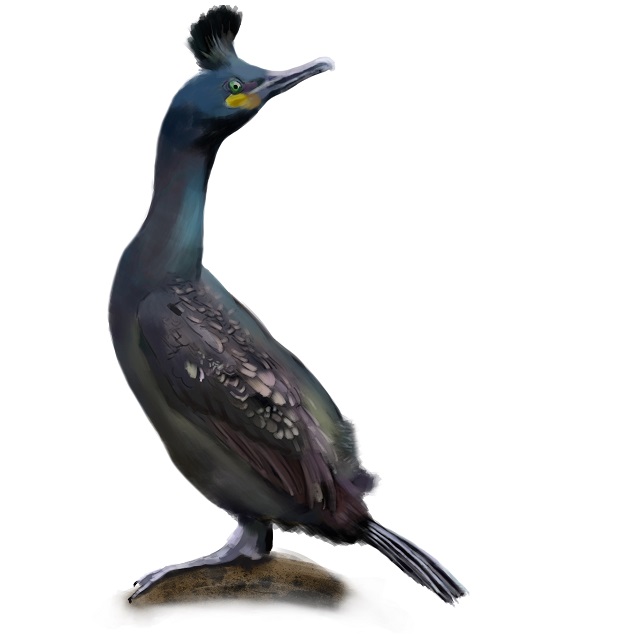
| Latin Name | Phalacrocorax aristotelis |
| Diet | Fish and molluscs, occasionally supplemented by crustaceans. |
| Best time to see | April to August. |
| Distribution | Can be found anywhere on the UK coastline, being more common in the north-west. |
| Habitat | European shags prefer rocky shores and inlets. |
| Migrant/Resident | Resident breeder. |
| Interesting fact | Being surprisingly efficient swimmers, European shags can dive down as deep as 45 m below the surface in pursuit of fish. |
Gulls
Kittiwake
Kittiwakes are medium-sized gulls, averaging about 40 cm in length, with 1.1 m wingspans. They are light grey above and white underneath, with small, yellow bills.
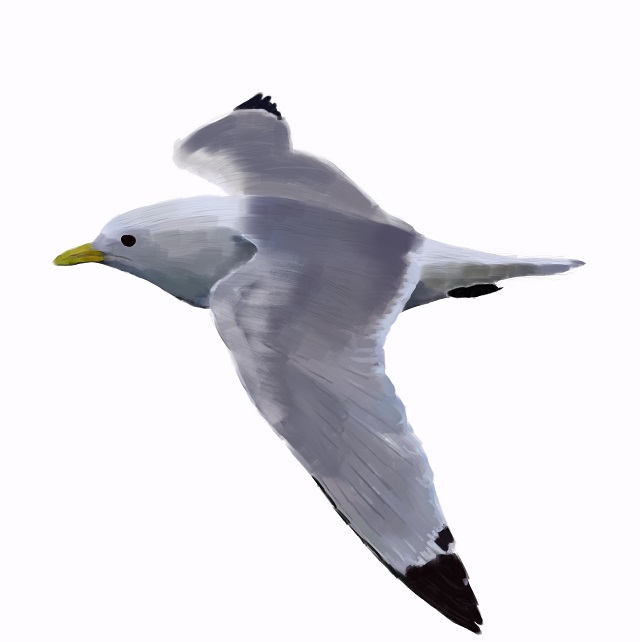
| Latin Name | Rissa tridactyla |
| Diet | They mainly feed on fish, although they will also eat shrimp and squid. |
| Best time to see | May to August. |
| Distribution | Kittiwakes spend the winter out at sea, but they can be found in scattered locations around the coast during summer. |
| Habitat | Kittiwakes choose to nest on coastal cliffs, often at large seabird colonies. |
| Migrant/Resident | Resident breeder and summer visitor. |
| Interesting fact | Kittiwakes are named after their distinctive “kit-ti-wake” calls, however they are very vocal and make a range of different noises, including high-pitched squeaks. |
Black-headed gull
A highly distinctive bird in summer, the black-headed gull has a light body and a dark head, although the head often turns white during the rest of the year. Averaging 37 cm in length, it has a 1 m wingspan.
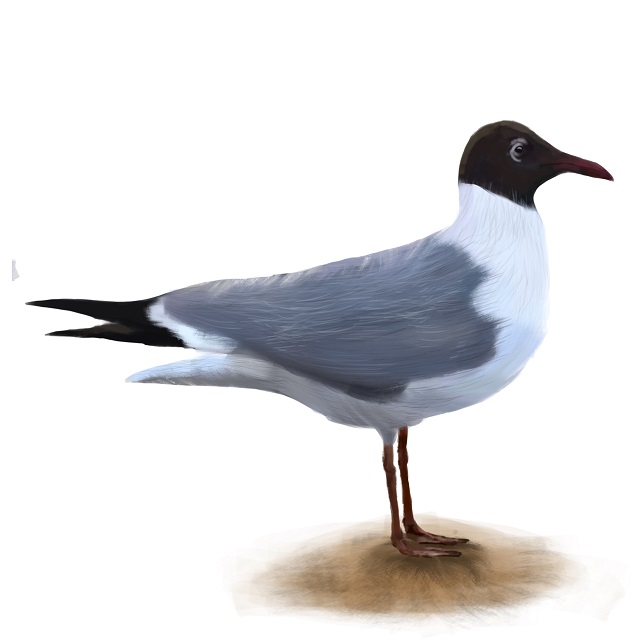
| Latin Name | Chroicocephalus ridibundus |
| Diet | The black-headed gull’s varied diet includes fish, carrion, insects and worms. |
| Best time to see | December to February. |
| Distribution | Very widespread, found right around the coast and absent only from upland areas. |
| Habitat | Black-headed gulls are common on wetland habitats such as saltmarsh and estuaries. |
| Migrant/Resident | Resident breeder. |
| Interesting fact | Black-headed gull chicks are often predated upon in the nest, so the parents try to disguise the nest by removing the leftover eggshells after the chicks have hatched. |
Common gull
Common gulls have white underbellies and black wingtips, with yellow legs and bills. Averaging around 41 cm, they have 1.2 m wingspans.

| Latin Name | Larus canus |
| Diet | Mostly fish and carrion, with worms being eaten on occasion. |
| Best time to see | December to February. |
| Distribution | Can be seen right around the UK coastline, being found year-round in the north and visiting southern England during winter. |
| Habitat | Common gulls make use of a range of habitats, breeding on coastal marsh, sea cliffs and beaches. They often feed on land fill sites. |
| Migrant/Resident | Resident breeder and winter visitor. |
| Interesting fact | Common gulls sometimes stamp vigorously on grass to imitate rainfall, encouraging worms and other invertebrates to the surface so that they can be caught. |
Lesser black-backed gull
The lesser black-backed gull has dark wings and a white underbelly, with yellowy-orange legs. They measure between 50 – 70 cm in length, with 1.4 m wingspans.

| Latin Name | Larus fuscus |
| Diet | These birds are omnivorous and feed on fish, insects, small mammals and berries, as well as scavenging carrion. |
| Best time to see | June to August |
| Distribution | Found right around the UK coastline in summer, often moving further inland in winter. |
| Habitat | On the coast, lesser black-backed gulls can be seen in areas of farmland, wetland and beach. |
| Migrant/Resident | Resident breeder and summer visitor. |
| Interesting fact | 40% of the European lesser black-backed gull population can be found in the UK, with the largest individual colony being found on Walney Island in Cumbria. |
Great black-backed gull
Averaging between 70 and 80 cm, the great black-backed gull is the largest gull in the world, with a 1.5 m wingspan. It can be distinguished from the lesser black-backed gull by having darker plumage.
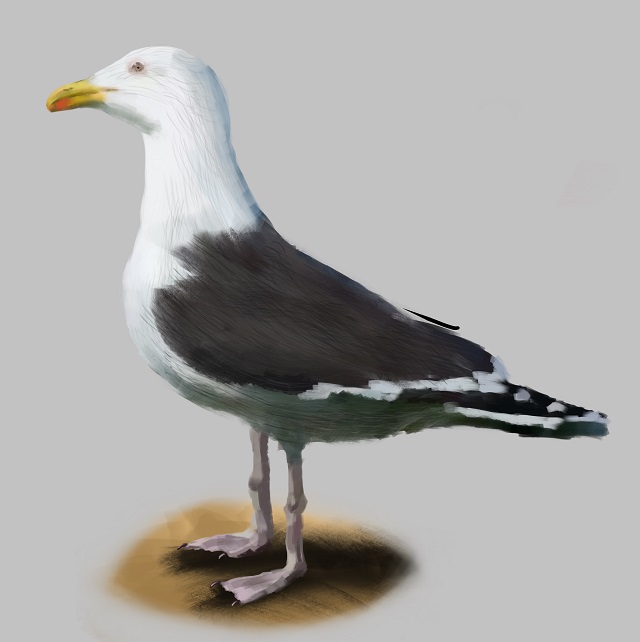
| Latin Name | Larus marinus |
| Diet | Great black-backed gulls are opportunistic omnivores but feed mainly on shellfish, carrion and smaller birds. |
| Best time to see | June to August. |
| Distribution | Can be seen anywhere on the coast during the summer breeding season, sometimes moving further inland during winter. |
| Habitat | Great black-backed gulls often congregate around harbours and landfill sites in the colder months, but they are widespread in coastal habitats at other times. |
| Migrant/Resident | Resident breeder. |
| Interesting fact | These powerful birds often behave more like raptors than gulls, preying on smaller animals and aggressively chasing other sea birds. |
European herring gull
Herring gulls have light grey wings and white lower regions, with pink legs. Averaging around 60 cm, they have wingspans of 1.4 m.

| Latin Name | Larus argentatus |
| Diet | They feed on a wide variety of foods, including fish, eggs, young birds, fruit and carrion. |
| Best time to see | April to August. |
| Distribution | Herring gulls are widespread on the UK coast but often spend the winter months further inland. |
| Habitat | Farmland, wetland and freshwater areas are all common habitats, along with towns and gardens. |
| Migrant/Resident | Resident breeder. |
| Interesting fact | Herring gulls are intelligent opportunists and have learnt to steal food right out of people’s hands in many seaside towns. |
Petrels
European storm petrel
European storm petrels are the UK’s smallest seabirds, averaging 16 cm in length, with 38 cm wingspans. They have dark brown bodies, patches of white on their rumps and short tails.
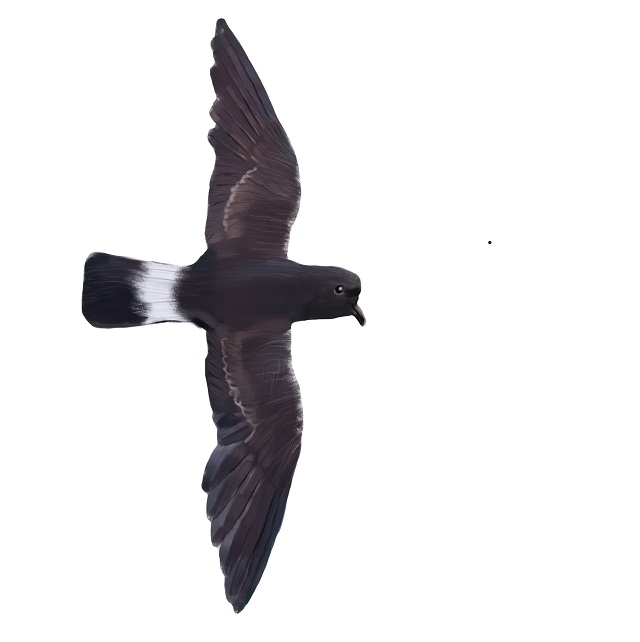
| Latin Name | Hydrobates pelagicus |
| Diet | Mainly fish, although crustaceans and plankton will also be eaten. |
| Best time to see | June to August. |
| Distribution | Breeds in western parts of the UK during summer, but can be seen elsewhere in spring and autumn. |
| Habitat | Islands and remote coastlines are the only places where the European storm petrel breeds. |
| Migrant/Resident | Breeding summer migrant. |
| Interesting fact | While nesting, European storm petrels produce a strange purring song in the dead of night, almost similar to that of a cat. They are normally silent at sea. |
Leach’s storm petrel
Leach’s storm petrel is a bird with dark plumage, a white rump and a forked tail. Is it a small bird, measuring about 20 cm in length, with a wingspan of 46 cm.

| Latin Name | Oceanodroma leucorhea |
| Diet | Primarily plankton, supplemented by small fish and crustaceans. |
| Best time to see | September to October. |
| Distribution | Leach’s storm petrels appear sporadically around the UK coastline, being seen most often from seawatching points around Liverpool Bay. |
| Habitat | Breeds on remote islands in north-west Scotland during summer, but is strictly an ocean bird at other times of year. |
| Migrant/Resident | Breeding summer visitor. |
| Interesting fact | For such small birds, Leach’s storm petrels are very long-lived, with the oldest individual reaching an impressive age of 38 years old. |
Shearwaters
Northern fulmar
Fulmars look similar to gulls, with white heads, light grey wings and pale underbellies. Despite this, they’re more closely related to albatrosses. They average 47 cm in length, with 1 m wingspans.
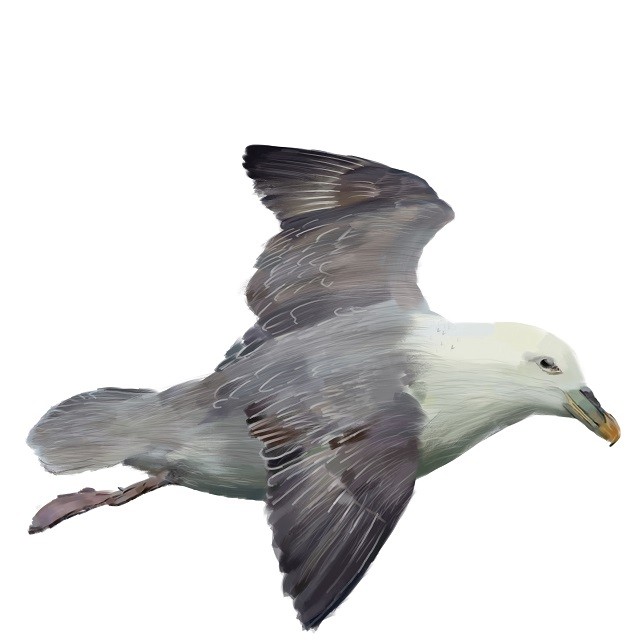
| Latin Name | Fulmarus glacialis |
| Diet | Fish, shrimp and squid make up most of a fulmar’s diet. |
| Best time to see | June to August. |
| Distribution | Nests around the UK coast in summer, although is most common in Scotland. |
| Habitat | Seabird colonies and high cliffs are the preferred nesting sites for fulmars. Outside of the breeding season, they remain offshore. |
| Migrant/Resident | Breeding summer visitor. |
| Interesting fact | Fulmars produce a form of stomach oil which can be sprayed from the mouth when the birds feel threatened. It can clog the plumage of predatory birds, preventing them from flying. |
Manx shearwater
Manx shearwaters are black and white birds with very long, straight wings. They are medium-sized, measuring about 35 cm, with an 82 cm wingspan.

| Latin Name | Puffinus puffinus |
| Diet | Mainly small fish such as sprat and sardines. |
| Best time to see | May to July. |
| Distribution | Manx shearwaters breed in remote areas, largely in the west of the country. They can be seen elsewhere on the coast during their migration periods. |
| Habitat | Breeding occurs on islands and quiet mainland coasts, where the terrain is good for building burrows. |
| Migrant/Resident | Breeding summer visitor. |
| Interesting fact | Manx shearwaters produce unusual midnight shrieks and screams, leading to historic beliefs that they were associated with ghosts or witches. |
Skuas
Arctic skua
Arctic skuas come in two colour morphs, with one being black and white and the other being uniformly brown. Both have pointed wings and measure around 44 cm, with 1.2 m wingspans.
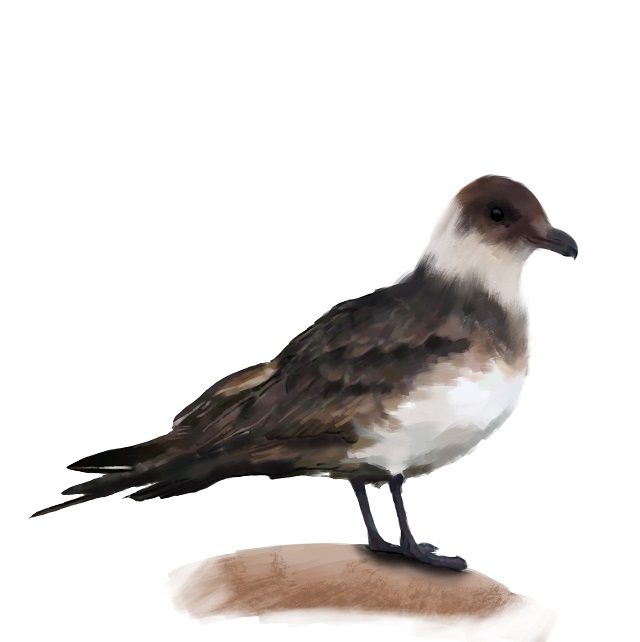
| Latin Name | Stercorarius parasiticus |
| Diet | They feed on small mammals, chicks and eggs in the breeding season, with fish being the primary source of food at other times. |
| Best time to see | June to August. |
| Distribution | Breeds only in northern Scotland but can be seen elsewhere on the British coast during spring and autumn migrations. |
| Habitat | Arctic skuas nest on islands and remote coastlines, often near seabird colonies. |
| Migrant/Resident | Breeding summer visitor. |
| Interesting fact | The Arctic skua is also known as the parasitic jaeger, due to its tendency to aggressively attack and steal food from other seabirds. |
Great skua
A large bird, the great skua measures about 60 cm in length and has a wingspan of 1.3 m. Its plumage is brown, with darker areas and golden streaks.
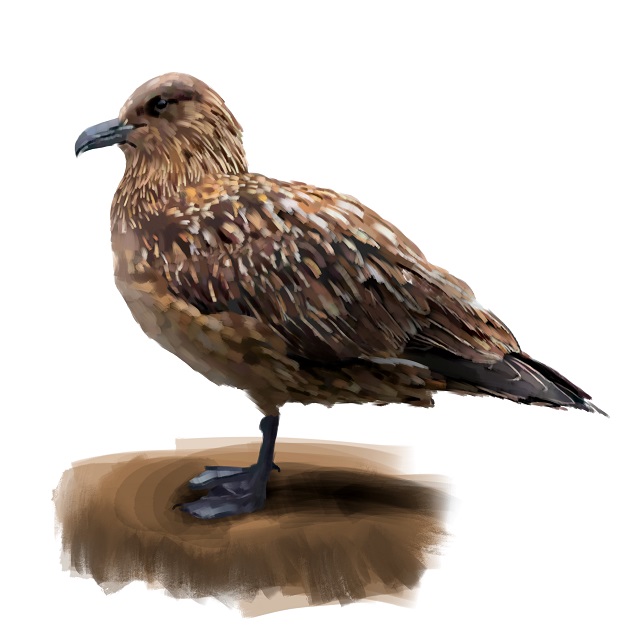
| Latin Name | Stercorarius skua |
| Diet | Mainly fish, eggs and other birds. Small mammals may also be caught on occasion. |
| Best time to see | June to August. |
| Distribution | Great skuas nest in remote coastal regions in north-west Scotland. They can be seen elsewhere on the UK coast as they migrate. |
| Habitat | Rocky islands and moorland are preferred habitats for breeding. Outside of the breeding season, seabird colonies are common places to find these birds. |
| Migrant/Resident | Breeding summer visitor. |
| Interesting fact | Great skuas are highly predatory and will often hunt and kill smaller seabirds such as puffins, along with stealing their food. This earns them the nickname “the pirates of the sea”. |
Terns
Little tern
A mixture of white and silvery-grey, the little tern has a black cap and a short tail. Measuring 23 cm in length, it has a wingspan of 52 cm.
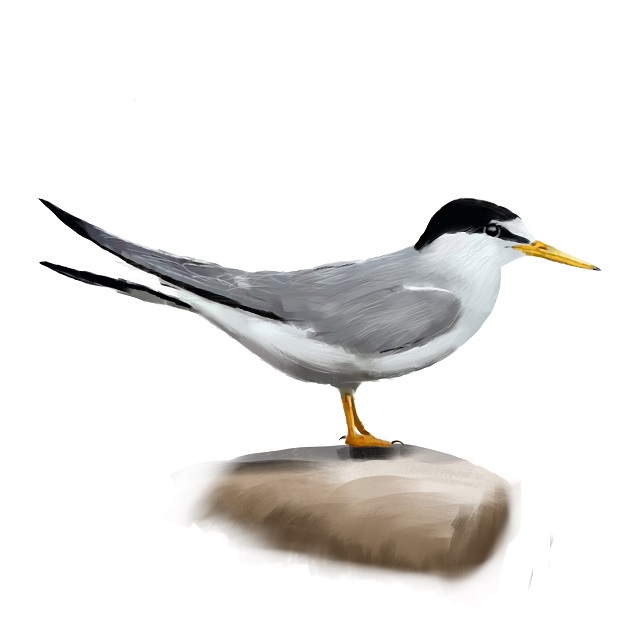
| Latin Name | Sternula albifrons |
| Diet | Mainly fish, which is caught during shallow dives. |
| Best time to see | June to August. |
| Distribution | Little terns can be seen around the UK coast, choosing to breed at localised sites. |
| Habitat | Nesting occurs on shingle beaches and rocky islands. Inshore waters are preferred areas for feeding. |
| Migrant/Resident | Breeding summer visitor. |
| Interesting fact | Little terns migrate south for the winter, setting out on incredible journeys to subtropical regions, which can sometimes cover more than 5,000 km. |
Sandwich tern
Sandwich terns are pale birds with black caps, which often feature ragged tufts of plumage. Averaging 38 cm in length, they have 1 m wingspans.
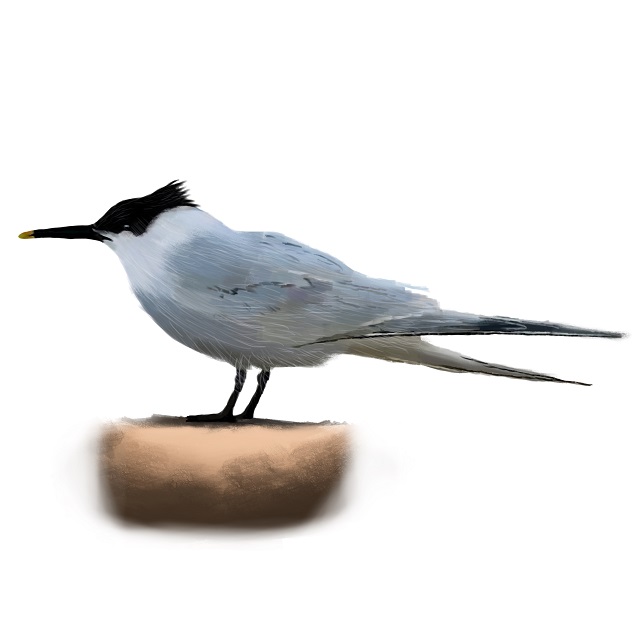
| Latin Name | Thalasseus sandvicensis |
| Diet | Mostly small fish such as sprat or sandeels. |
| Best time to see | May to August. |
| Distribution | Breeding colonies of sandwich terns occur sporadically on the UK coast, with large examples in north Norfolk and Minsmere. The species can also be seen while migrating, mostly on the south-east coast. |
| Habitat | Sandwich terns prefer to nest on sandy beaches and remote islands. |
| Migrant/Resident | Breeding summer visitor. |
| Interesting fact | Sandwich terns range far and wide in search of suitable fishing grounds, with some birds travelling as far as 70 km in just one day. |
Common tern
Common terns are silvery-grey birds with black caps and orange beaks. They have characteristically long tails. Averaging 33 cm in length, they have wingspans of 88 cm.

| Latin Name | Sterna hirundo |
| Diet | Mostly fish, but occasionally invertebrates such as worms and molluscs. |
| Best time to see | June to August. |
| Distribution | Common terns breed during summer at locations around the UK coastline. They can also be seen migrating during autumn. |
| Habitat | This species prefers rocky coastlines, choosing to breed on areas of shingle beach or gravel. |
| Migrant/Resident | Breeding summer visitor. |
| Interesting fact | Common terns often nest in very large colonies, which can sometimes number up to 20,000 individuals. |
Arctic tern
A white bird with a black cap, the Arctic tern measures 34 cm in length, with a wingspan of 80 cm. It has very long tail streamers and a blood-red bill.
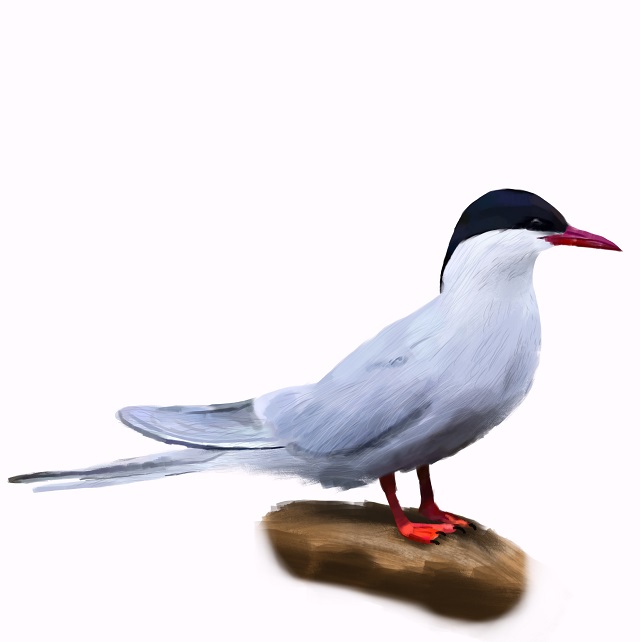
| Latin Name | Sterna paradisaea |
| Diet | Fish is preferentially taken but is supplemented by crustaceans and insects. |
| Best time to see | April to August. |
| Distribution | Breeding occurs largely on northern coastlines, especially on the north-west Scottish islands. The species can be seen right around the UK during its autumn migration. |
| Habitat | Arctic terns nest in coastal habitats such as tundra and moorland, often on remote islands. |
| Migrant/Resident | Breeding summer visitor. |
| Interesting fact | Arctic terns defend their nests very aggressively from anything they see as a threat. They will attack large predators and even humans, using a combination of dive-bombing and striking. |
Herons & Egrets
Great Bittern
The great bittern is a large heron with excellent camouflage, its plumage being a mixture of pale brown feathers and dark streaks. Measuring 75 cm in length on average, it has a wingspan of 1.3 m.
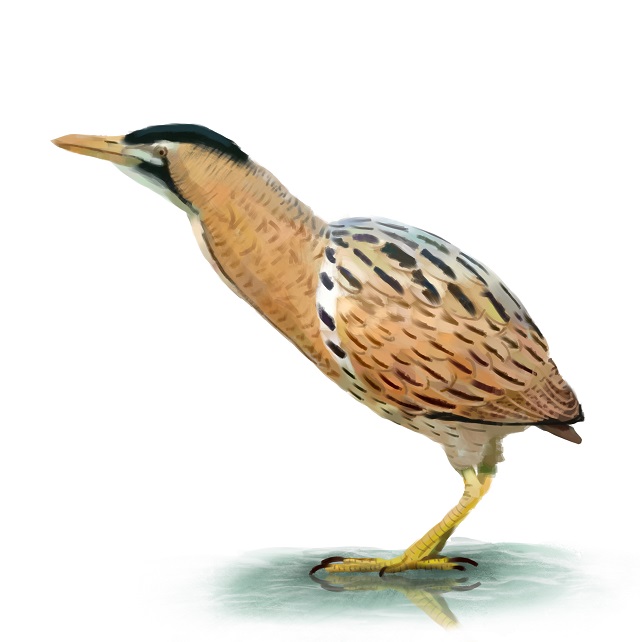
| Latin Name | Botaurus stellaris |
| Diet | Fish and amphibians make up most of its diet, although crustaceans will also be taken. |
| Best time to see | December to February. |
| Distribution | Great bitterns are mainly found in England and Wales, both on the coast and inland. Although they can be seen year-round in some locations, most are only obvious during winter. |
| Habitat | The species usually resides in wetland areas with large reedbeds. |
| Migrant/Resident | Resident breeder and winter visitor. |
| Interesting fact | Male bitterns produce a deep, fog-horn-like boom during the breeding season – a sound which can be heard from over 3 miles away |
Grey Heron
Grey herons are tall birds with very long necks and plumage which is largely grey in colour. They are very large, measuring about 94 cm in length, with 1.8 m wingspans.
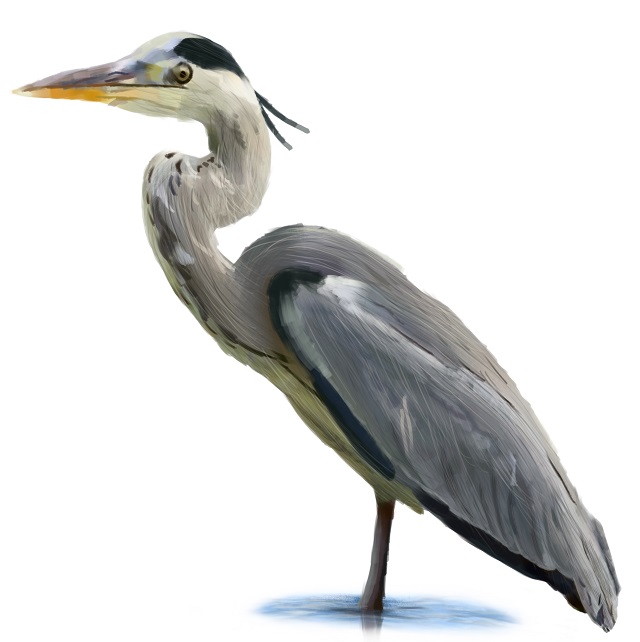
| Latin Name | Ardea cinerea |
| Diet | Mainly fish and amphibians, with occasional small mammals. |
| Best time to see | December to February. |
| Distribution | Grey herons are present in all parts of the UK, with the exception of mountainous regions. |
| Habitat | The species can be found anywhere with water, especially rocky coastlines, ponds and rivers. |
| Migrant/Resident | Resident breeder. |
| Interesting fact | Grey herons are one of the first birds of the year to breed in the UK, sometimes laying eggs in early February in southern regions. |
Little Egret
The little egret is a small heron with pure white plumage, black legs and yellow feet. During the breeding season, it has long plumes on its head. Averaging 60 cm in length, it has a 92 cm wingspan.

| Latin Name | Egretta garzetta |
| Diet | Fish is eaten most often, with amphibians and molluscs being taken on occasion. |
| Best time to see | December to February. |
| Distribution | Largely found in southern regions, particularly on the south coast of England. While some stay in the UK year-round, many are winter migrants. |
| Habitat | Coastal wetlands and estuaries are preferred, although the species will sometimes be seen further inland along lakes and rivers. |
| Migrant/Resident | Resident breeder and winter visitor. |
| Interesting fact | The plume feathers of little egrets were highly prized in the 18th and 19th centuries, so much so that they were more valuable than gold. The hunting of the species for this reason led to huge declines. |
Swans & Geese
Mute Swan
The mute swan is a large waterbird with white plumage and an orange bill. It also has a very long, S-shaped neck. Measuring 1.5 m in length, it has a 2.2 m wingspan.

| Latin Name | Cygnus olor |
| Diet | Mute swans feed mostly on aquatic plants, although they will also eat crops. |
| Best time to see | April to August. |
| Distribution | Spread throughout the UK, mute swans breed everywhere other than northern Scotland and upland areas. |
| Habitat | Mute swans prefer freshwater habitats and are common in wetland areas, as well as ponds and lakes. |
| Migrant/Resident | Resident breeder. |
| Interesting fact | Contrary to popular belief, mute swan’s wings are not powerful enough to break the arms or legs of a person. They do defend their nests aggressively, however, and will chase off intruders by hissing, pecking and wing-flapping. |
.
Whooper swan
Whooper swans are large birds that measure 1.5 m in length, with wingspans of 2.3 m. They have white plumage and thin necks, with bills that are a mixture of yellow and black.
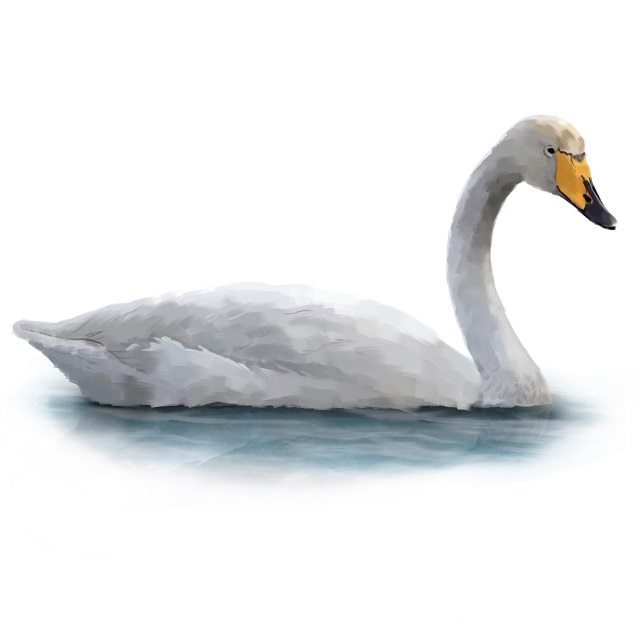
| Latin Name | Cygnus cygnus |
| Diet | Mainly aquatic plants that grow beneath the water, but occasionally grains. |
| Best time to see | December to February. |
| Distribution | Whooper swans can be found in lowland regions of Scotland, Northern Ireland and predominantly northern parts of England and Wales. |
| Habitat | Wetland and farmland are their preferred habitats, but they are frequently seen on the coast. |
| Migrant/Resident | Winter visitor. |
| Interesting fact | The term “swan song” – meaning a final gesture or effort before death – may stem from the whooper swan’s tendency to make a series of song-like noises just before it dies. |
Brent goose
The brent goose is the smallest goose in the UK, averaging about 57 cm in length, with a wingspan of 1.5 m. It has a black neck and a grey back, with a small white patch on its neck.
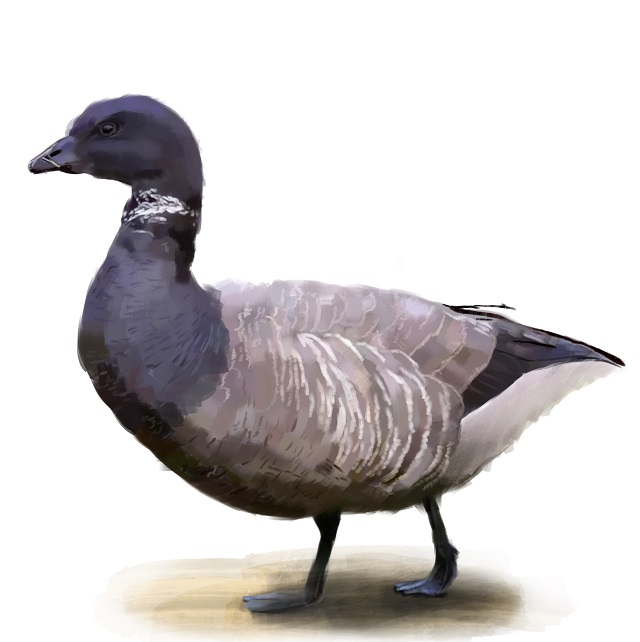
| Latin Name | Branta bernicla |
| Diet | Feeds on marine plants such as eelgrass, as well as terrestrial grass and cereal crops. |
| Best time to see | December to February. |
| Distribution | Visits coastlines around the UK but is most common in eastern England. |
| Habitat | Brent geese prefer estuaries and saltmarsh, although they will also visit farmland. |
| Migrant/Resident | Winter visitor. |
| Interesting fact | Brent geese possess highly developed salt glands which allow them to drink seawater without suffering any harm. |
Canada goose
Canada geese are distinctive birds with black heads, black necks and white throat patches. Their bodies are light brown. Measuring about 95 cm in length on average, they have 1.6 m wingspans.
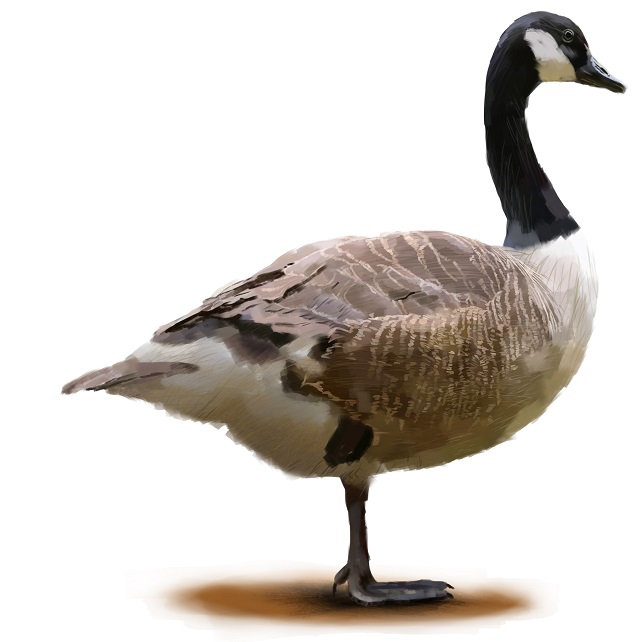
| Latin Name | Branta canadensis |
| Diet | Mainly herbivorous, they feed on grasses, grains and aquatic algae. |
| Best time to see | January to December. |
| Distribution | Widespread in southern regions of the UK, being less common in Scotland and Northern Ireland. |
| Habitat | Canada geese are found mainly in freshwater habitats such as wetland, as well as farmland near the coast. |
| Migrant/Resident | Resident breeder (introduced). |
| Interesting fact | Native to North America, Canada geese were first introduced to the UK in the 17th century. They have successfully spread throughout much of the country and are now sometimes considered a pest. |
Barnacle goose
The barnacle goose is a medium-sized goose that averages 63 cm in length, with a 1.3 m wingspan. It has a white face with a black and white body, and dark legs.
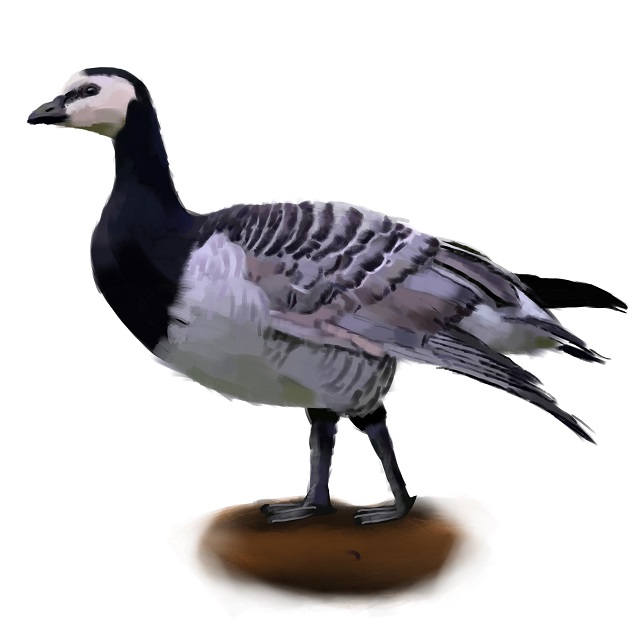
| Latin Name | Branta leucopsis |
| Diet | Eats the leaves and shoots of grasses, as well as seeds. |
| Best time to see | December to February. |
| Distribution | Can be seen on much of the British coastline, with the highest concentrations in the Solway Firth. |
| Habitat | Barnacle geese reside in coastal farmland habitats, as well as wetlands and ponds. |
| Migrant/Resident | Winter visitor. |
| Interesting fact | As barnacle geese breed near the arctic, medieval people in Britain were confused as to where young birds came from. This led to the belief that they hatched from barnacles – from where the species gets its name. |
Greylag Goose
Greylag geese are light grey birds with dark wings and pink legs. They are one of the largest geese found in the UK, measuring about 83 cm in length, with 1.6 m wingspans.
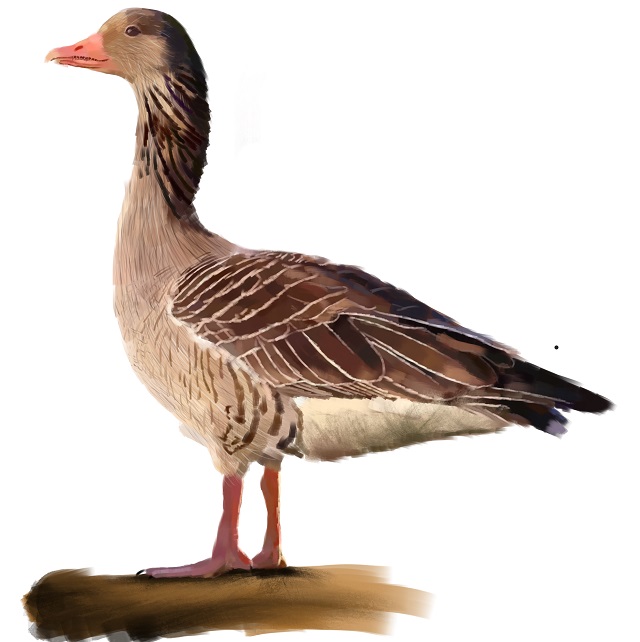
| Latin Name | Anser anser |
| Diet | They feed mostly on grass shoots and cereal crops. |
| Best time to see | December to February. |
| Distribution | Feral greylag geese are seen year-round in many lowland regions, while wild birds arrive in winter and nest mostly in northern areas. |
| Habitat | Seen in a range of habitats, including farmland, wetland areas and reservoirs. |
| Migrant/Resident | Resident breeder and winter visitor. |
| Interesting fact | The greylag goose is the closest relative to the domestic goose, thought to have been tamed in the 14th century and bred for its meat. |
Pink-footed Goose
A grey bird with a pink bill, the pink-footed goose is named after its distinctive pink feet. It’s a small goose species, measuring 68 cm in length, with a wingspan of 1.5 m.
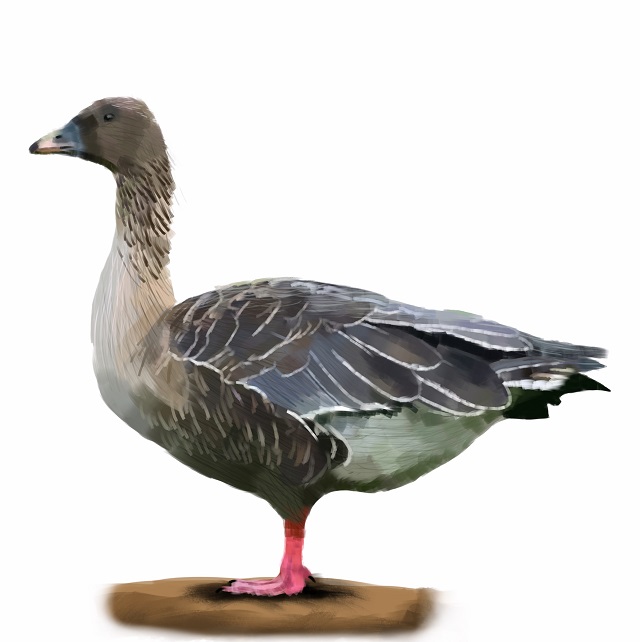
| Latin Name | Anser brachyrhynchus |
| Diet | The species feeds on cereal crops, grasses and aquatic plants. |
| Best time to see | December to February. |
| Distribution | Mostly seen on the coast, especially in eastern parts of the country. |
| Habitat | Large estuaries such as the Solway Firth are preferred, with farmland and coastal wetlands being other places to see them. |
| Migrant/Resident | Winter visitor. |
| Interesting fact | During their annual migrations, pink-footed geese can travel at speeds of up to 40 mph when the wind is at their backs. |
Ducks
Common shelduck
The common shelduck is a colourful bird with a dark green head and neck, a red bill and a chestnut stripe across the chest. It’s a large duck – averaging 61 cm in length, with a 1.1 m wingspan.
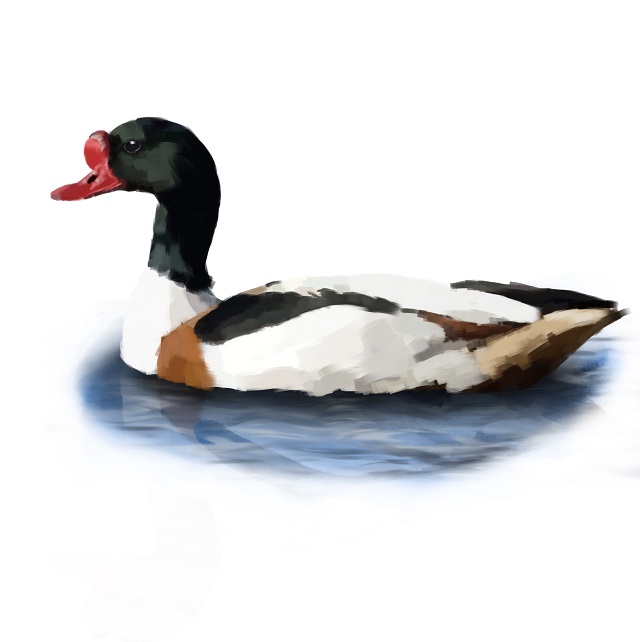
| Latin Name | Tadorna tadorna |
| Diet | Feeds mostly on invertebrates and aquatic molluscs. |
| Best time to see | December to February. |
| Distribution | Shelducks are found in coastal areas right around the UK, although they can sometimes be seen further inland. |
| Habitat | Inshore coastal waters are their preferred habitat, along with reservoirs and wetlands. |
| Migrant/Resident | Resident breeder and winter visitor. |
| Interesting fact | Unusually for a duck, the shelduck likes to nest in rabbit burrows and tree holes, where between 8 and 10 eggs are laid. |
Northern shoveler
Named after its broad, distinctive bill, the northern shoveler measures 50 cm in length and has a 77 cm wingspan. The males have green heads and a mixture of orange and white plumage, while females are a mottled brown.
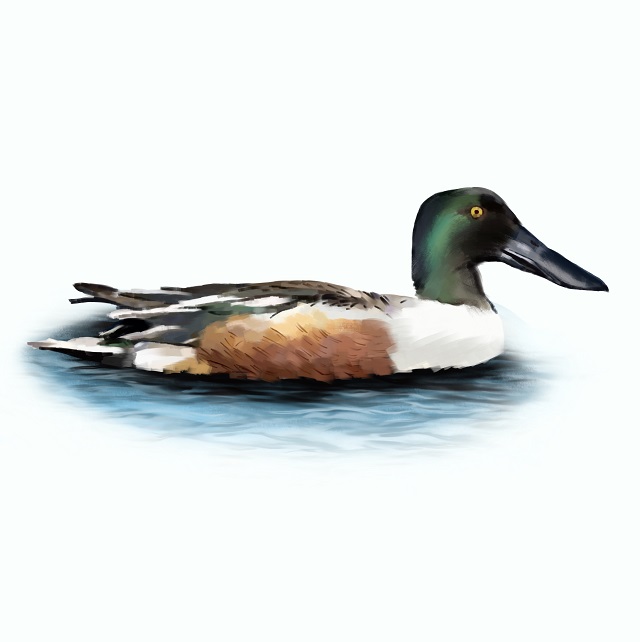
| Latin Name | Spatula clypeata |
| Diet | Small insects make up the majority of its diet, along with aquatic plant matter. |
| Best time to see | December to February. |
| Distribution | Found throughout large parts of the UK but mainly in southern regions. It is present all year-round, although is most common in winter. |
| Habitat | Coastal regions and freshwater habitats such as wetlands. |
| Migrant/Resident | Resident breeder and winter visitor. |
| Interesting fact | The bill of a northern shoveler is a highly developed tool, equipped with comb-like edges which allow the bird to sieve small invertebrates from the water. |
Gadwall
Gadwalls are medium-sized ducks that average 51 cm in length, with 90 cm wingspans. Both sexes have dark grey plumage, with black rear ends and obvious white patches on their wings.
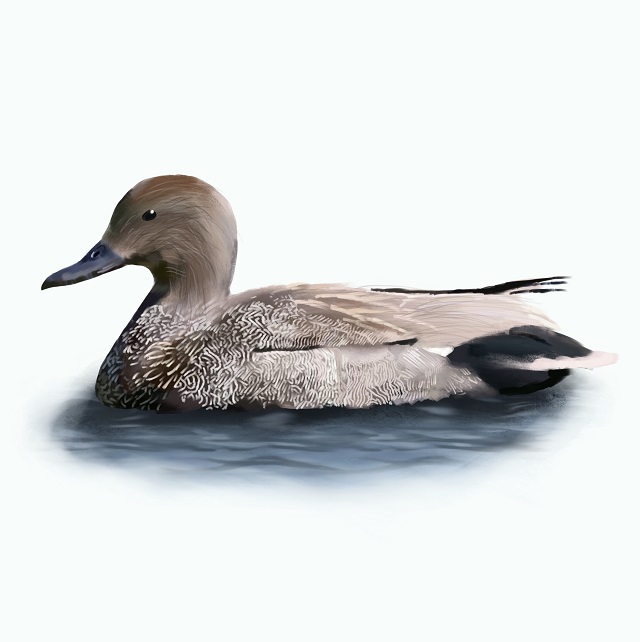
| Latin Name | Mareca strepera |
| Diet | Aquatic vegetation is their primary food, although insects may also be eaten. |
| Best time to see | December to February. |
| Distribution | Gadwalls live mostly in the Midlands and south-east England, but there are also populations in north-east Scotland and Wales. |
| Habitat | Mostly seen in coastal wetlands and estuaries, although they often breed on the edges of lakes and reservoirs. |
| Migrant/Resident | Resident breeder and winter visitor. |
| Interesting fact | During the breeding season, male gadwalls engage in courtship displays towards females, often raising their heads and flashing the white feathers on their wings. |
Eurasian wigeon
Male wigeons have brown heads, pink breasts and grey bodies, whereas females are dark brown. Averaging 45 cm in length, they have 80 cm wingspans.
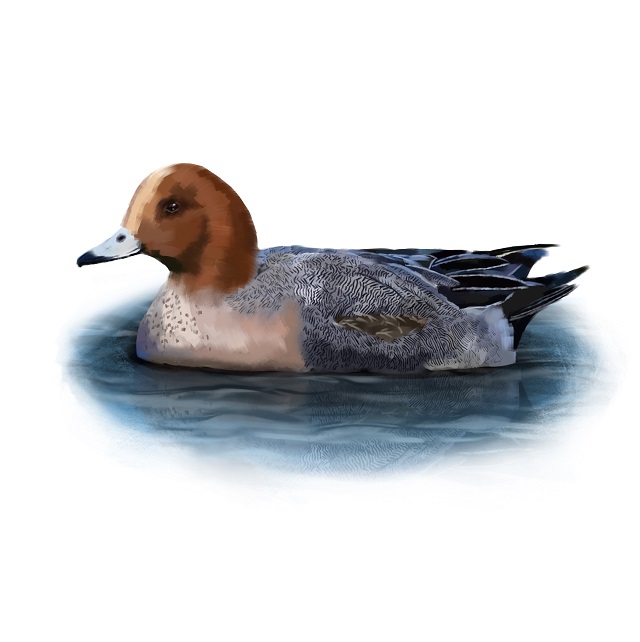
| Latin Name | Mareca penelope |
| Diet | Mainly aquatic vegetation. |
| Best time to see | December to February. |
| Distribution | Mostly seen around the coast, throughout the UK. Some pairs breed in Cambridgeshire and the north of Scotland. |
| Habitat | Estuaries and coastal wetland habitats are the best places to see Eurasian wigeons. |
| Migrant/Resident | Resident breeder and winter visitor. |
| Interesting fact | Although some wigeons live here all year-round, many migrate north after winter, spending the summer months in Iceland, Scandinavia and Russia. |
Mallard
One of the most recognisable duck species, the mallard is a large species, measuring 57 cm in length, with 90 cm wingspans. Females have mottled brown plumage, whereas males have green heads and grey bodies.

| Latin Name | Anas platyrhynchos |
| Diet | Their omnivorous diets are varied, including berries, plant matter, invertebrates and molluscs. |
| Best time to see | January to December. |
| Distribution | Mallards are the most widespread duck in the UK, found almost everywhere. |
| Habitat | All water bodies are used, although freshwater habitats such as wetlands are preferred. |
| Migrant/Resident | Resident breeder. |
| Interesting fact | Mallards were the first species of bird found to sleep with one eye open, as a way to detect predators. To do this, they shut down half of their brain at a time. |
Northern pintail
The northern pintail can be identified by its long tail feathers and is a large duck, measuring 60 cm in length, with 88 cm wingspans. Males have brown heads and a mix of grey and white body plumage, while females are largely brown.
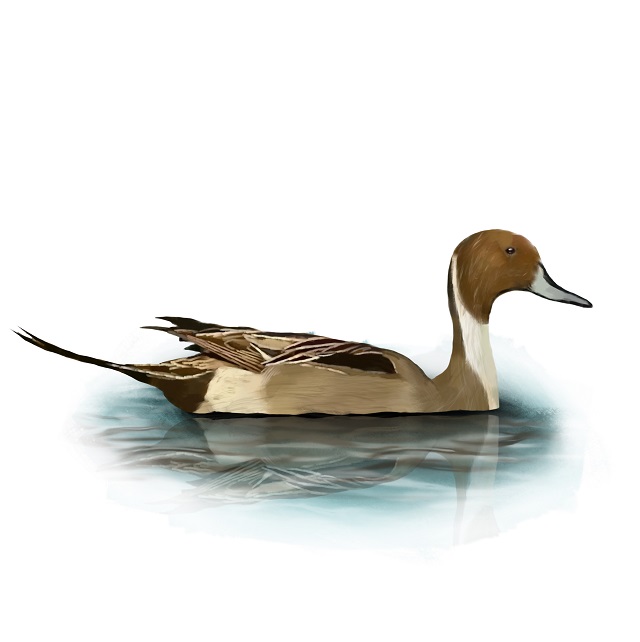
| Latin Name | Anas acuta |
| Diet | Mainly aquatic plants in winter and invertebrates in summer. |
| Best time to see | December to February. |
| Distribution | Pintails are found locally around the UK coastline, with some pairs breeding in Scotland and eastern England. |
| Habitat | Sheltered coasts and large estuaries such as the Dee Estuary are their preferred habitat. |
| Migrant/Resident | Resident breeder and winter visitor. |
| Interesting fact | Northern pintails are dabbling ducks, finding their food by upending themselves in shallow water and using their long necks to reach the bottom |
Eurasian teal
The Eurasian teal is the smallest duck species in the UK, measuring 36 cm in length, with a 61 cm wingspan. Both sexes have a green wing patch, but females are mottled brown, with males having brown with males having brown and green patches on their heads.
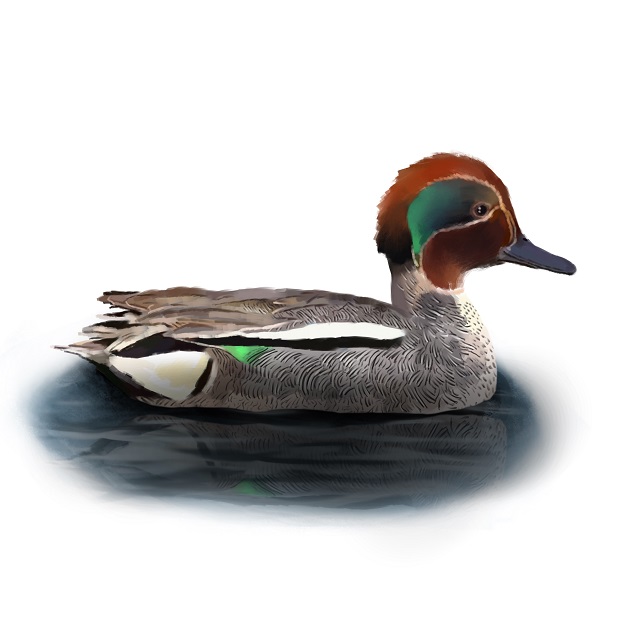
| Latin Name | Anas crecca |
| Diet | Mainly aquatic invertebrates such as crustaceans, with seeds sometimes being eaten in winter. |
| Best time to see | December to February. |
| Distribution | Teal can be seen anywhere in the UK, but are especially common in upland regions in summer, moving to the coast in winter. |
| Habitat | Mainly freshwater habitats such as lakes, reservoirs and wetlands. |
| Migrant/Resident | Resident breeder and winter visitor. |
| Interesting fact | Young teal leave the nest just a few hours after hatching and are led to nearby water by their mothers, who look after them for about a month. |
Common pochard
Female common pochards have light brown and grey plumage, while males have a mixture of grey and white colours, with rufous heads. Measuring 46 cm in length, they have 77 cm wingspans.
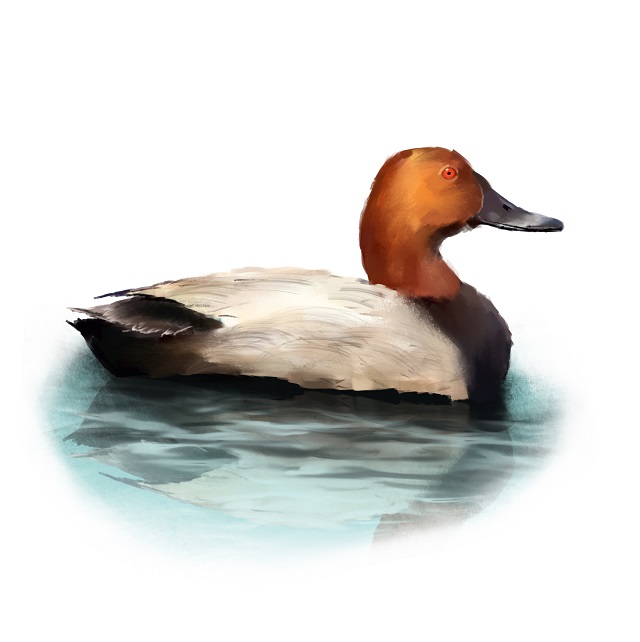
| Latin Name | Aythya ferina |
| Diet | Mainly aquatic plants, supplemented by molluscs, insects and small fish. |
| Best time to see | December to February. |
| Distribution | Widespread in coastal regions, the common pochard can be found in large parts of England and Wales, being less common elsewhere. |
| Habitat | Mostly seen on large lakes, reservoirs and estuaries. |
| Migrant/Resident | Resident breeder and winter visitor. |
| Interesting fact | Although male pochards are colourful during the breeding season, they moult afterwards, developing ‘eclipse plumage’ – ensuring they are less obvious to predators. |
Tufted duck
The tufted duck is easily recognisable by the feathery tufts on the back of its head. Both sexes have dark plumage, although males sport large white patches of their sides. The species measures 43 cm in length, with a 70 cm wingspan.
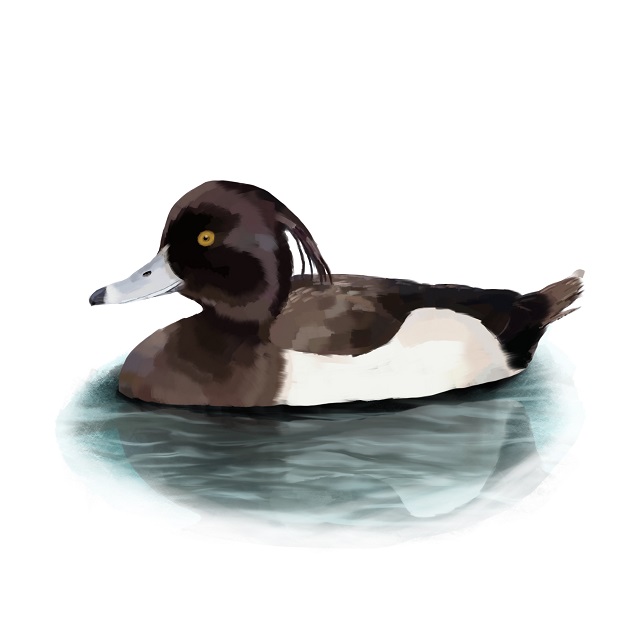
| Latin Name | Aythya fuligula |
| Diet | Molluscs and insects are preferred, with aquatic vegetation also being eaten. |
| Best time to see | December to February. |
| Distribution | Tufted ducks are found in lowland regions right around the UK. |
| Habitat | Most often seen in reservoirs, lakes and wetland areas. |
| Migrant/Resident | Resident breeder and winter visitor. |
| Interesting fact | The tufted duck is a diving species and will duck under the water for up to a minute in search of food, often doing so in small groups. |
Common eider
The eider is a large, heavy species of duck, measuring about 57 cm in length, with a wingspan of 94 cm. Females are mottled brown in colour, while males are black and white with yellowish bills.
| Latin Name | omateria mollissima |
| Diet | Mostly shellfish such as mussels. |
| Best time to see | December to February. |
| Distribution | Only found on the coast, eiders live right around the UK. They breed in Scotland and northern England in summer, but are seen further south during winter. |
| Habitat | Primarily inshore waters, especially around rocky coasts. |
| Migrant/Resident | Resident breeder and winter visitor. |
| Interesting fact | Eiders are famed for their very soft, downy feathers, which females use to line their nests. The feathers were so sought after by humans that the species nearly went extinct in the 19th century. |
Common scoter
Male common scoters are all-black, with females having browner plumage. Both sexes have a large, bulbous bill. They average 48 cm in length, with 84 cm wingspans.
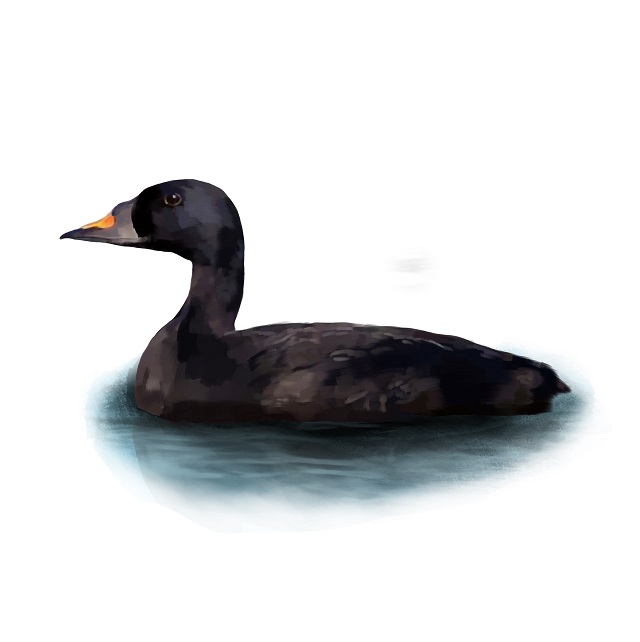
| Latin Name | Melanitta nigra |
| Diet | Crustaceans and molluscs are commonly consumed, along with the occasional insect. |
| Best time to see | December to February. |
| Distribution | Scoters can be found around the UK coast, but only breed in small lochs in Scotland. |
| Habitat | Mostly seen in inshore waters, especially in bays and estuaries. |
| Migrant/Resident | Resident breeder and winter visitor. |
| Interesting fact | Scoters dive for their food, often keeping their wings open while underwater – a behaviour that helps keep them balanced and gives the impression that they are ‘flying’. |
Common goldeneye
Hence their name, goldeneyes can be identified by their distinctive yellow eyes. Females are grey with rufous heads, while males are black and white with green heads. They measure 44 cm in length, with 72 cm wingspans.
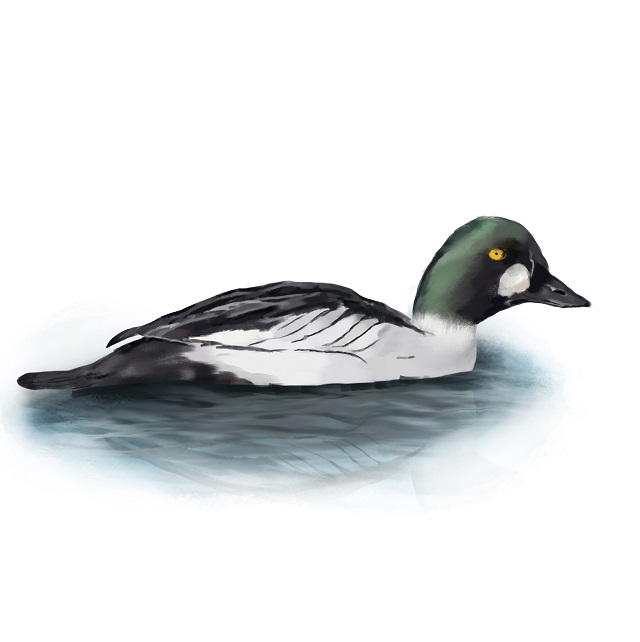
| Latin Name | Bucephala clangula |
| Diet | Crustaceans, insects and molluscs, supplemented by aquatic plants. |
| Best time to see | December to February. |
| Distribution | Most common in north-west Britain, although they can be found almost anywhere. They only breed in the Scottish Highlands. |
| Habitat | Lakes and large rivers are preferred by goldeneyes, although they also frequent sheltered coasts. |
| Migrant/Resident | Resident breeder and winter visitor. |
| Interesting fact | Goldeneye choose to nest in tree cavities near water, but they will also use nest boxes. The provision of such nesting sites in Scotland has encouraged the species to breed more readily in recent years. |
Goosander
The goosander is a medium-sized duck with a long bill. Males are white with green heads, while females are grey with brown heads. The species averages 63 cm in length, with a wingspan of 90 cm.
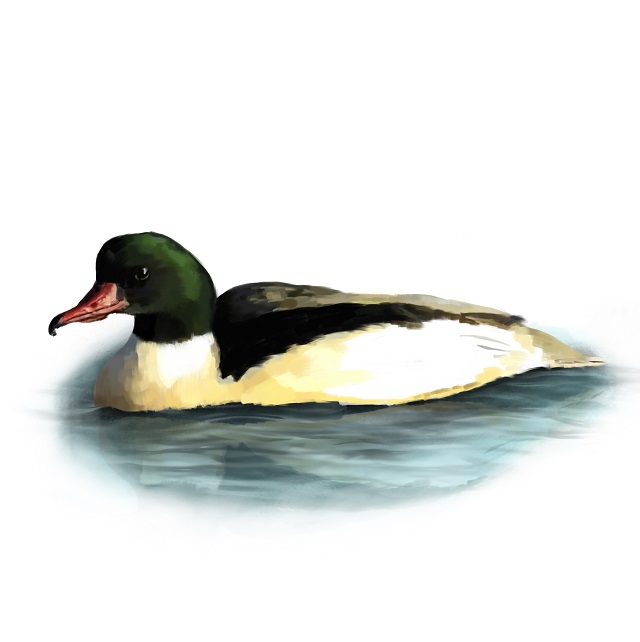
| Latin Name | Mergus merganser |
| Diet | Mainly fish but occasionally crustaceans and molluscs. |
| Best time to see | December to February. |
| Distribution | Present throughout much of the country, goosanders can be found in upland areas during summer, moving towards the coast in winter. |
| Habitat | Seen in mountain rivers, as well as reservoirs, lakes and estuaries. |
| Migrant/Resident | Resident breeder and winter visitor. |
| Interesting fact | The bill of a goosander is highly serrated, possessing a series of sharp teeth-like structures which help the bird keep hold of fish. |
Red-breasted merganser
The red-breasted merganser is a slender duck that measures 55 cm in length, with a 78 cm wingspan. Females tend to be grey with rufous-coloured heads, while males have green heads and orange breasts.
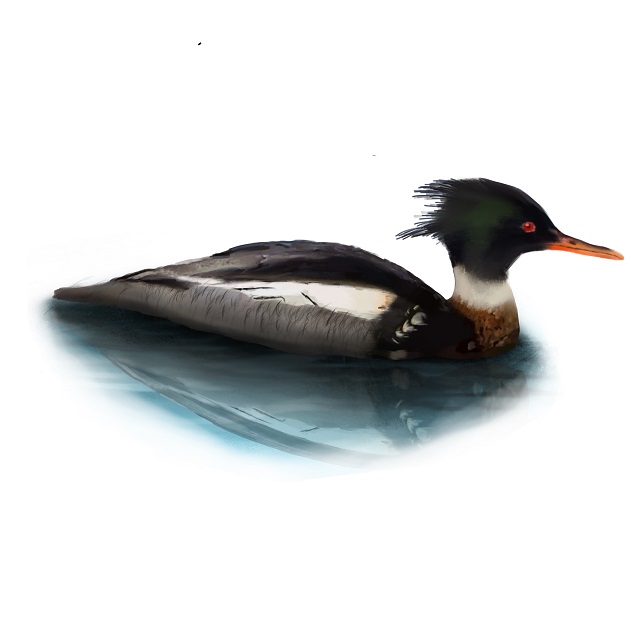
| Latin Name | Mergus serrator |
| Diet | Fish are their most common food. |
| Best time to see | November to February. |
| Distribution | Red-breasted mergansers can be seen in north-western regions of Scotland, England and Wales. Elsewhere, they are seen on the coast during winter. |
| Habitat | Nests on lakes and rivers but often feeds in inshore waters. |
| Migrant/Resident | Resident breeder and winter visitor. |
| Interesting fact | The red-breasted merganser is the fastest duck ever recorded, with one individual observed at a wind-assisted speed of 100 mph while escaping a plane. |
Oystercatchers
Eurasian oystercatcher
Oystercatchers are large wading birds, measuring 42 cm on average, with 83 cm wingspans. They are black and white, with long red legs and a red bill.
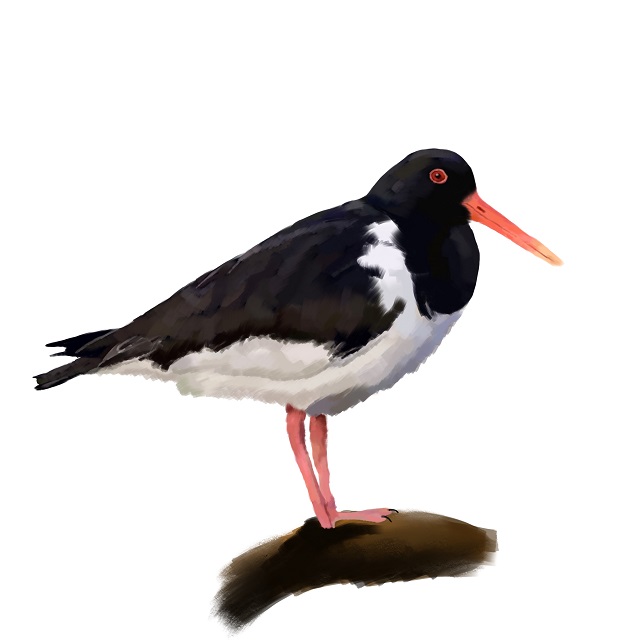
| Latin Name | Haematopus ostralegus |
| Diet | Mussels and cockles are eaten most often, supplemented by worms. |
| Best time to see | January to December. |
| Distribution | Found right around the UK coast. Less common further inland. |
| Habitat | Found right around the UK coast. Less common further inland. |
| Migrant/Resident | Resident breeder. |
| Interesting fact | Despite their name, Oystercatchers do not feed on oysters very often, however they are one of the few species of bird who are capable of opening these tough shellfish. |
Rails & Coots
Water rail
Water rails have grey bodies with black and brown streaks on their wings. Their feet are large and they have long, red bills. Averaging 28 cm in length, they have 42 cm wingspans.
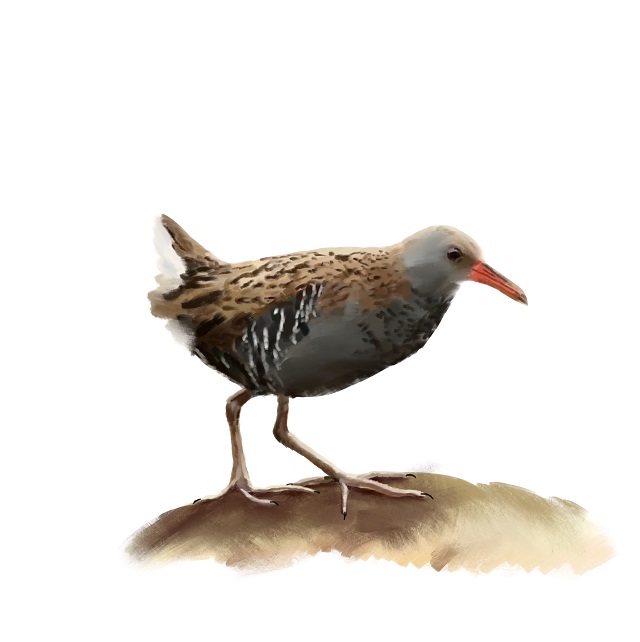
| Latin Name | Rallus aquaticus |
| Diet | Their omnivorous diet includes worms, molluscs and insects, along with occasional plant matter. |
| Best time to see | January to December. |
| Distribution | Widely found in southern regions of the UK, being most common in eastern England. |
| Habitat | Water rail prefer freshwater habitats and are often seen in wetland areas and around lakes that are fringed with dense vegetation. |
| Migrant/Resident | Resident breeder. |
| Interesting fact | Water rail are one of the most secretive birds in the UK. They are rarely seen out in the open and almost never fly during daylight hours, preferring instead to skulk through the vegetation. |
Corncrake
Corncrakes are lightly-coloured birds with small, squat bodies and long legs. They measure 28 cm in length and have 50 cm wingspans.
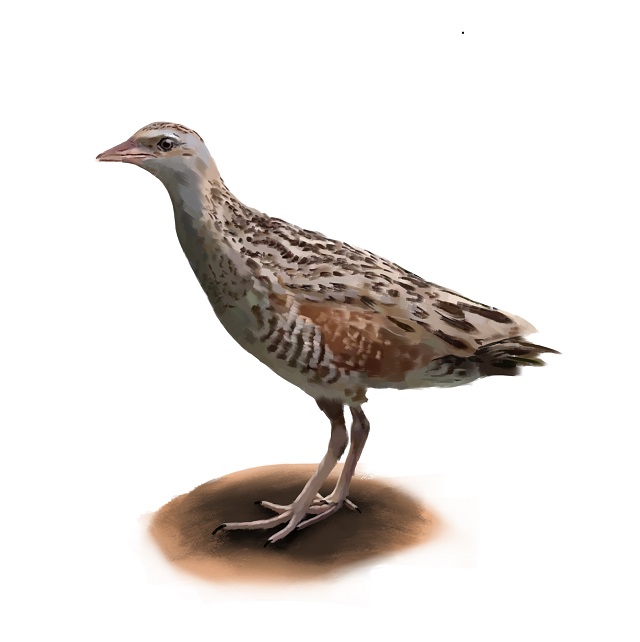
| Latin Name | Crex crex |
| Diet | Feeds mainly on insects and grass seeds. |
| Best time to see | June to August. |
| Distribution | Corncrakes are largely found in the north-west islands of Scotland, with small populations living on the coast in Northern Ireland. |
| Habitat | Primarily a terrestrial bird, corncrakes can be seen in meadows and open farmland. |
| Migrant/Resident | Breeding summer visitor. |
| Interesting fact | During the breeding season, male corncrakes produce a rasping call during the night. It can sometimes be heard as far as 1.5 km away. |
Common moorhen
The moorhen is a very recognisable bird, with dark plumage and a small red bill. It also has small white patches on its wings. The species averages about 33 cm in length, with a 52 cm wingspan.
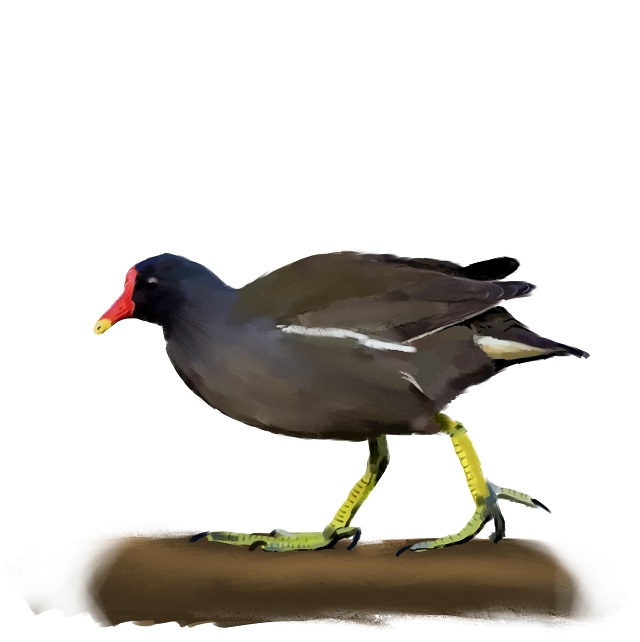
| Latin Name | Gallinula chloropus |
| Diet | Its varied diet includes aquatic plants, berries, insects and molluscs. |
| Best time to see | January to December. |
| Distribution | Found almost everywhere, apart from upland regions and areas of north-west Scotland. |
| Habitat | Moorhens are birds of freshwater habitats, being particularly common in wetlands, canals and rivers. |
| Migrant/Resident | Resident breeder. |
| Interesting fact | Despite its common name, moorhens are very rarely found on moors, with the name likely to be a corruption of ‘mirehen’ or ‘marshhen’. |
Coot
The coot is closely related to the moorhen but is larger, measuring 38 cm on average, with a 75 cm wingspan. Its plumage is uniformly black and it has a small, white bill.

| Latin Name | Fulica atra |
| Diet | Largely made up of aquatic plants, molluscs and seeds. |
| Best time to see | January to December. |
| Distribution | Found throughout lowland regions of the UK, only being absent from north-west Scotland. |
| Habitat | Coots are widespread in towns and countrysides, being common in wetland areas and often moving towards the coast during winter. |
| Migrant/Resident | Resident breeder. |
| Interesting fact | While diving for food, the coot can compress its wings in order to squeeze out as much trapped air as possible, allowing it to dive for longer periods. |
Avocets
Pied avocet
An elegant bird, the pied avocet has long legs and a long bill that curves upwards at the end. Its plumage is a mixture of black and white. Averaging 44 cm in length, it has a 78 cm wingspan.
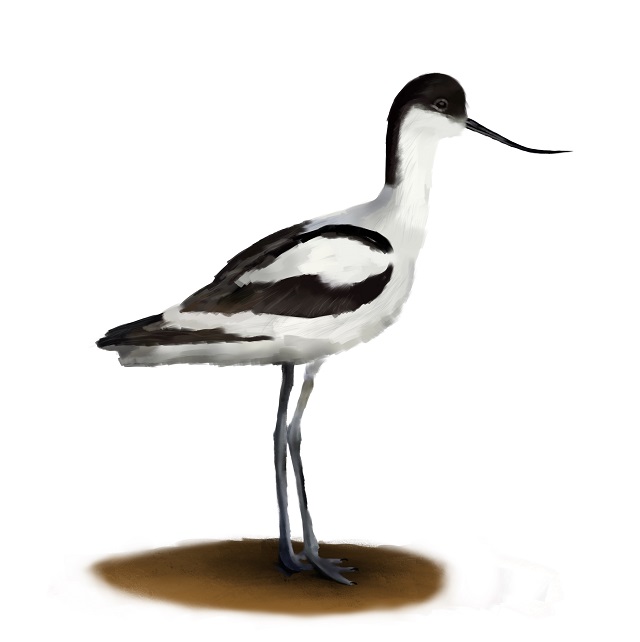
| Latin Name | Recurvirostra avosetta |
| Diet | Pied avocets mostly feed on insects and crustaceans. |
| Best time to see | January to December. |
| Distribution | Pied avocets are mainly found in south-east regions of the UK, with the largest populations found on the east coast of England. |
| Habitat | Coastal lagoons and estuaries are preferred. |
| Migrant/Resident | Resident breeder. |
| Interesting fact | Pied avocets use their long bills to scythe through the water from side to side, filtering out food as they go. This feeding technique is not found in any other species. |
Plovers
Ringed plover
Ringed plovers have white underbellies and brown wings, with black and white bands around their faces. Their orange bills have a black tip. Measuring 19 cm in length, the species has a 52 cm wingspan.
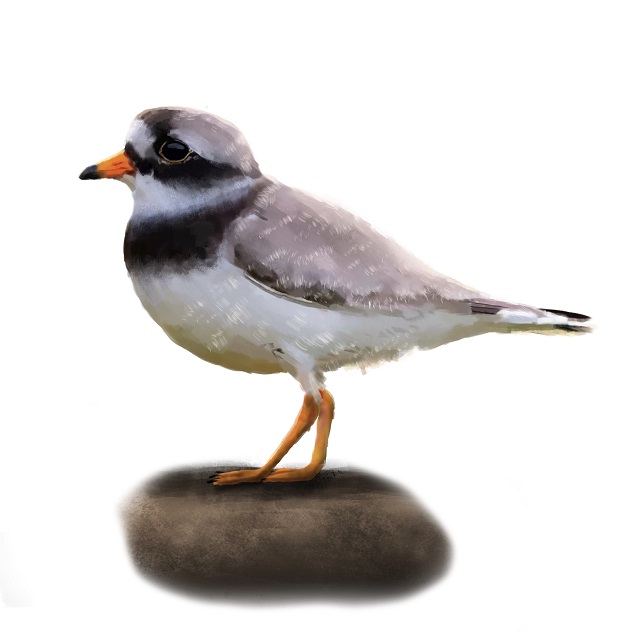
| Latin Name | Charadrius hiaticula |
| Diet | Mostly insects and crustaceans, supplemented by worms and molluscs. |
| Best time to see | June to August. |
| Distribution | Ringed plovers are common sights on coastlines around the UK, although they tend to move further inland during summer to breed. |
| Habitat | Mostly found on beaches and coastal wetland. |
| Migrant/Resident | Resident breeder and summer visitor. |
| Interesting fact | Parent ringed plovers will sometimes feign broken wings to lure predators away from their nests, putting themselves at risk to protect their young. |
European golden plover
Named after their speckled black and gold plumage, European golden plovers have black underbellies in summer, which turn mottled in colour during winter. They measure 27 cm in length, with 72 cm wingspans.
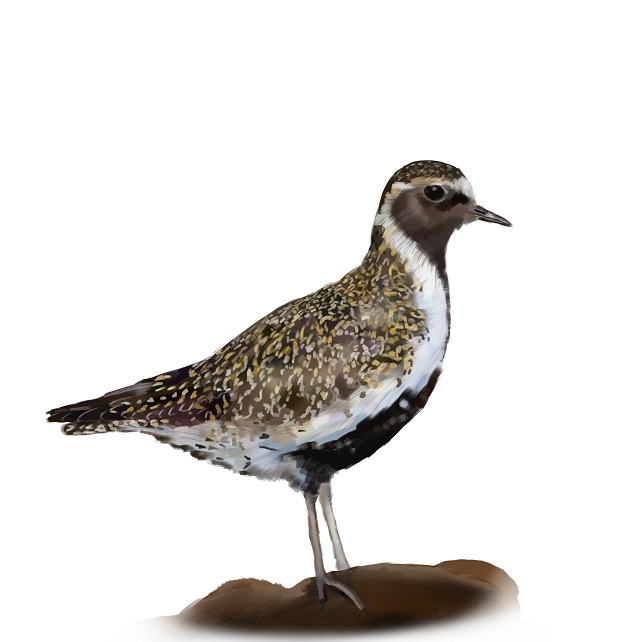
| Latin Name | Pluvialis apricaria |
| Diet | Worms and insects are their main foods. |
| Best time to see | December to February. |
| Distribution | Golden plovers are found in upland regions of Scotland and northern England during summer, before moving to coastlines around the country in winter. |
| Habitat | Moorland is preferred for nesting, with farmland and coastal estuaries being key habitats in winter. |
| Migrant/Resident | Resident breeder and winter visitor. |
| Interesting fact | A debate over whether the golden plover was the fastest game bird in Europe was the inspiration for the popular book, the Guinness World Records. As for the original debate, the golden plover is indeed the fastest. |
Lapwing
Lapwings have black and white plumage and can be identified by their long crests and rounded wings. Measuring about 30 cm in length, they have 84 cm wingspans.
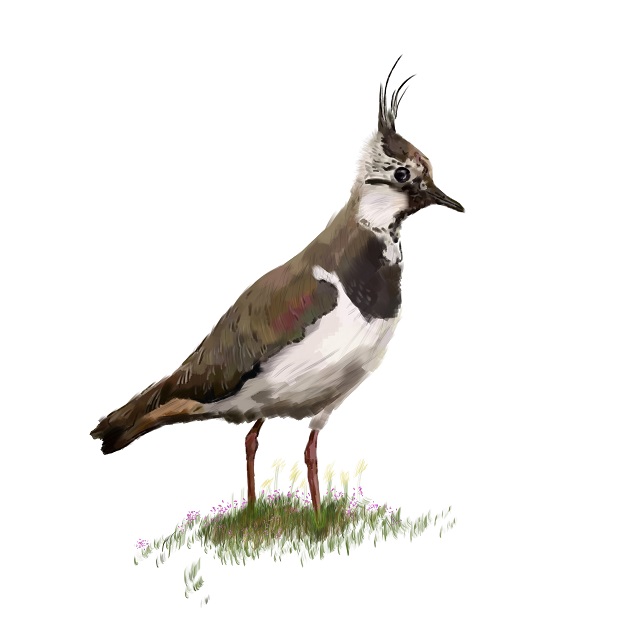
| Latin Name | Vanellus vanellus |
| Diet | Largely insects and other invertebrates such as worms. |
| Best time to see | January to December. |
| Distribution | Lapwings are found throughout the UK, predominantly in lowland regions of northern England and eastern Scotland. |
| Habitat | They are seen most often on farmland and open meadows, although they also reside in wetlands and coastal estuaries. |
| Migrant/Resident | Resident breeder. |
| Interesting fact | The lapwing is also commonly known as the ‘peewit’ – a name which stems from its high-pitched calls. Males call extensively during the breeding season, while putting on impressive aerial displays for females. |
Sandpipers
Red knot
The red knot is a dumpy bird with short legs, measuring 24 cm in length, with a 59 cm wingspan. It is silvery-grey during the winter, but develops a colourful red breast during the breeding season.
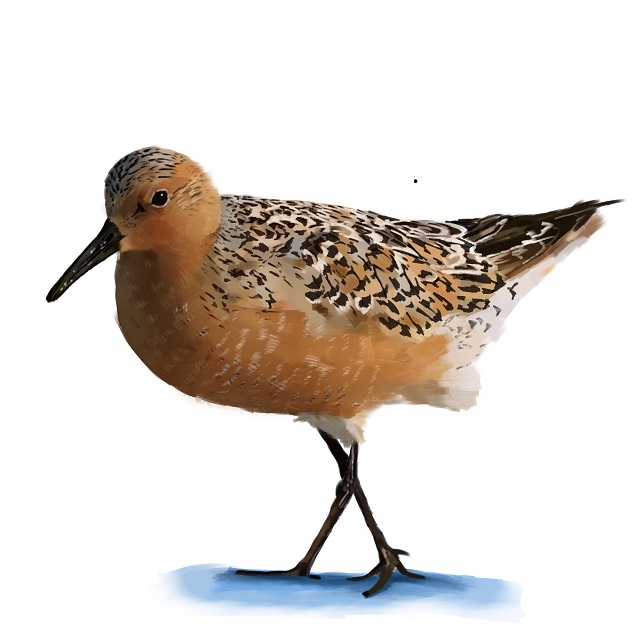
| Latin Name | Calidris canutus |
| Diet | Shellfish and worms make up most of its diet, with the occasional insect. |
| Best time to see | December to February. |
| Distribution | Present on coastlines around the country, although less common in the north-west. |
| Habitat | Red knots are primarily coastal birds, with muddy estuaries being their preferred habitat. |
| Migrant/Resident | Resident breeder. |
| Interesting fact | The tip of a red knot’s bill has specialised sensory organs – known as Herbst corpuscles – which alert the bird to changes in pressure as it probes the mud. This indicates areas where shells and other creatures may be hiding. |
Sanderling
Sanderlings are small, plump wading birds that average 20 cm in length, with 42 cm wingspans. They have white underbellies and grey upper parts, with dark legs.
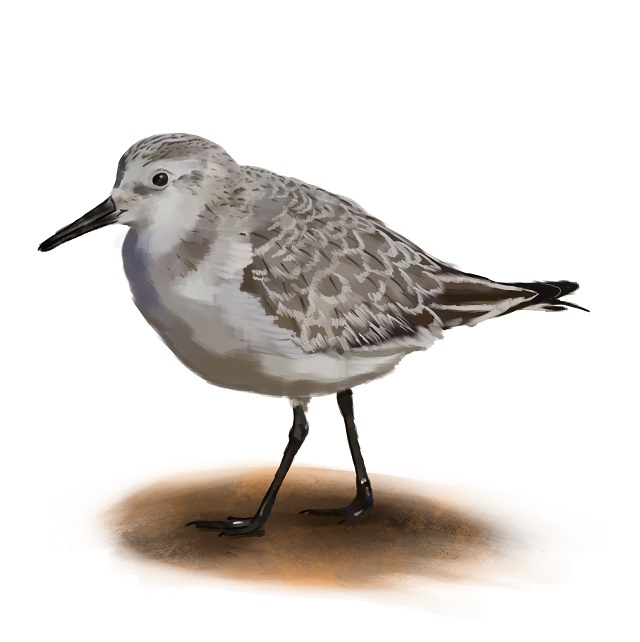
| Latin Name | Calidris alba |
| Diet | Marine worms, crustaceans and molluscs. |
| Best time to see | December to February. |
| Distribution | With the exception of southern England and western Scotland, sanderlings are common around the UK. |
| Habitat | A coastal species, the sanderling can be found on sandy beaches and mudflats. |
| Migrant/Resident | Resident breeder. |
| Interesting fact | Sanderlings have a very distinctive running action due to not having hind toes – an unusual characteristic among the sandpiper family. This adaptation allows them to run very fast as they dodge the waves on sandy shores. |
.
Common sandpiper
Common sandpipers have greenish-brown plumage above, with white underbellies and green legs. Averaging 20 cm in length, they have 40 cm wingspans.
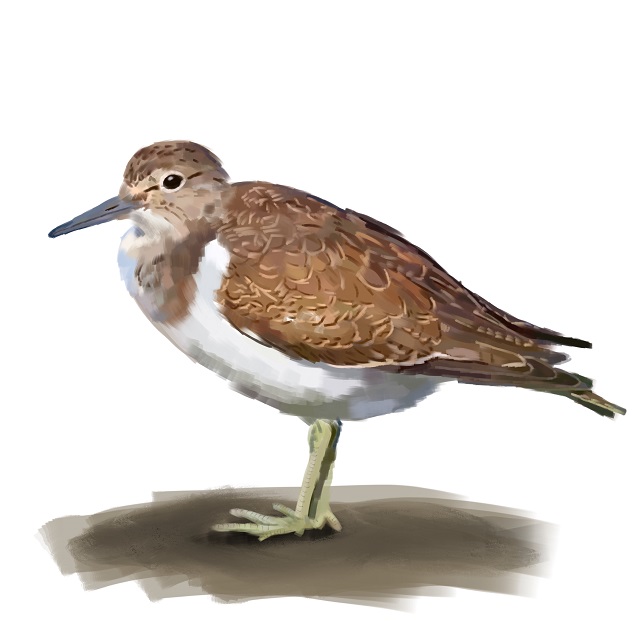
| Latin Name | Actitis hypoleucos |
| Diet | They feed mostly on aquatic invertebrates such as worms, as well as insects. |
| Best time to see | June to August. |
| Distribution | Seen mainly on the south coast of England in winter, being more widespread during summer. |
| Habitat | Common sandpipers breed around lakes and rivers, but can be found on coastal wetlands and estuaries at other times of year. |
| Migrant/Resident | Resident breeder and summer visitor. |
| Interesting fact | The common sandpiper often appears to be a very nervous bird, as it repeatedly bobs up and down while on the ground – a behaviour known as ‘teetering’. |
Dunlin
The dunlin can be distinguished by having a black belly patch and reddish-brown plumage during the summer. In winter, they become greyer. Measuring about 19 cm in length, they have 40 cm wingspans.
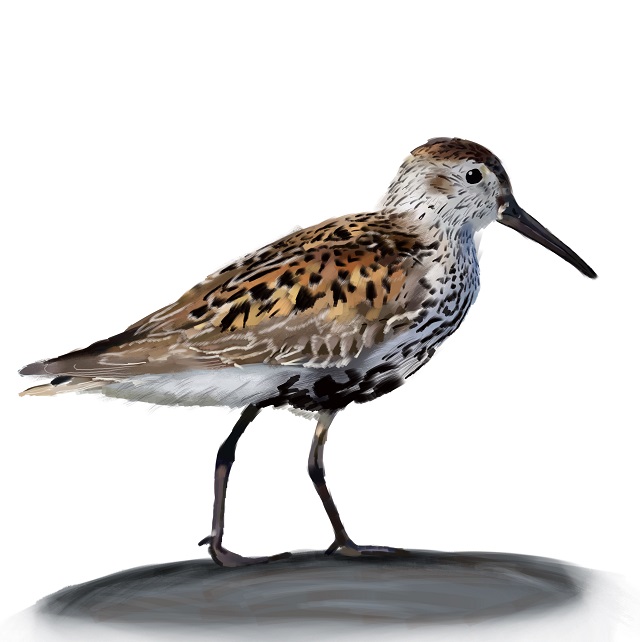
| Latin Name | Calidris alpina |
| Diet | Molluscs, worms and insects. |
| Best time to see | December to February. |
| Distribution | Found right around the UK coast, although they are most common in north-west Scotland and other upland areas during the breeding season. Elsewhere, they are largely seen in winter. |
| Habitat | Upland moors and bog are preferred for breeding, while estuaries are important feeding grounds. |
| Migrant/Resident | Resident breeder. |
| Interesting fact | Dunlins are often seen in very large flocks – known as ‘flings’. These can number well into the thousands and individuals within the group execute coordinated manoeuvres to avoid aerial predators. |
Turnstone
Turnstones have white underbellies, brown wings and a mixture of black and white markings on their face. They are medium-sized sandpipers, measuring 22 cm in length, with 54 cm wingspans.
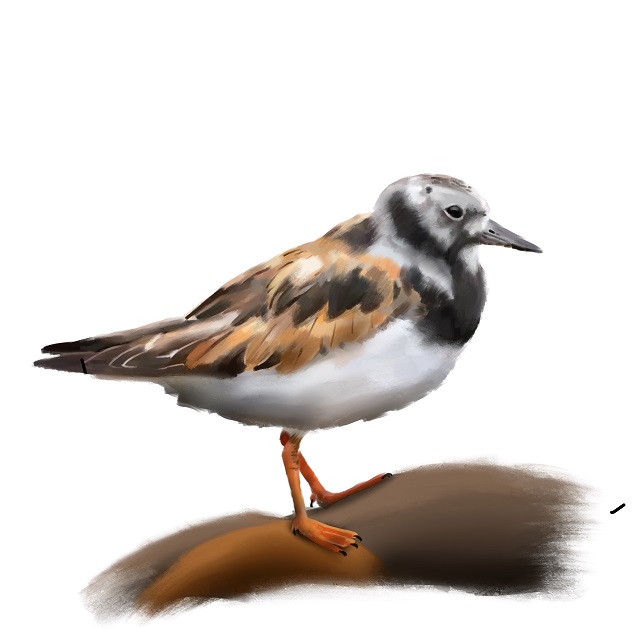
| Latin Name | Arenaria interpres |
| Diet | Mostly worms and molluscs, with insects being an important food source in summer. |
| Best time to see | December to February. |
| Distribution | Common right around the UK coast. |
| Habitat | Turnstones can be seen on rocky shores, as well as muddy estuaries and beaches. |
| Migrant/Resident | Resident breeder and winter visitor. |
| Interesting fact | Turnstones get their name from their tendency to flip stones over with their bills, in order to find snails and other marine creatures hiding underneath. |
Bar-tailed Godwit
Bar-tailed godwits have grey-brown plumage in winter, which turns brick-red in summer. They are tall wading birds with long beaks, and average 38 cm in length, with 75 cm wingspans.
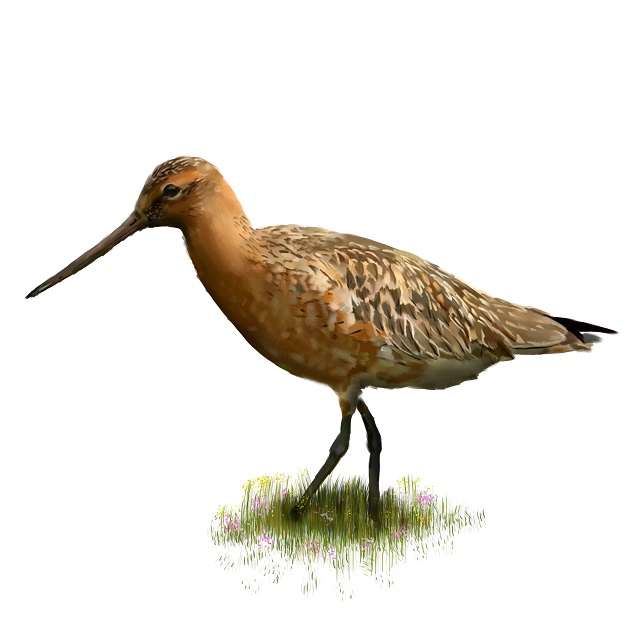
| Latin Name | Limosa lapponica |
| Diet | Marine worms and crustaceans make up the majority of their diet. |
| Best time to see | November to February. |
| Distribution | Present on coastlines everywhere in the UK. |
| Habitat | A wide range of coastal habitats are utilised by the bar-tailed godwit, but it is most often seen in large estuaries. |
| Migrant/Resident | Winter visitor. |
| Interesting fact | Bar-tailed godwits undertake the longest non-stop migrations of any bird, with one bird found to cover more than 11,500 km without stopping. |
Curlew
A tall, long-legged bird, the curlew has mottled brown plumage and can be identified by its long, curved bill. It measures 55 cm in length on average, with a 90 cm wingspan.
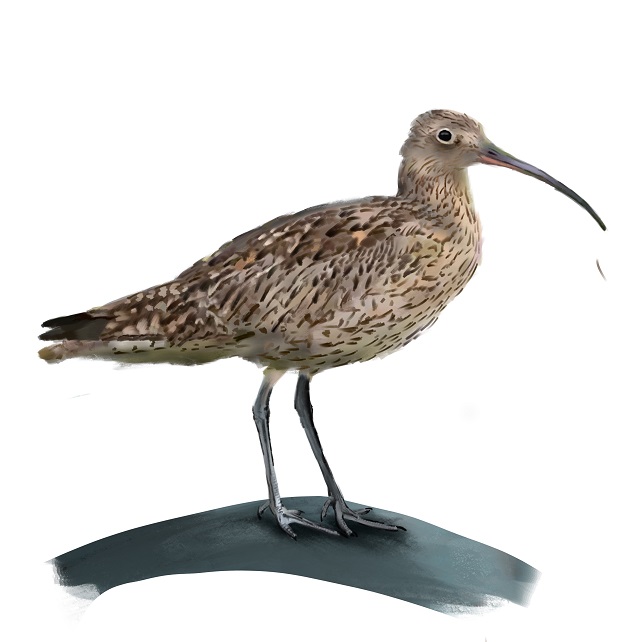
| Latin Name | Numenius arquata |
| Diet | Worms and shellfish are consumed most often, while crustaceans may be taken on occasion. |
| Best time to see | January to December. |
| Distribution | Curlews can be found right around the UK coastline, with large breeding populations in Wales, Scotland and northern England. |
| Habitat | Upland moors and heath are preferred for breeding, although the species can often be seen on coastal wetlands and estuaries. |
| Migrant/Resident | Resident breeder. |
| Interesting fact | Curlews were once widely eaten in the UK, even being served in pies in Cornwall. Since then, their numbers have decreased sharply and they are now a threatened species. |
Common redshank
The common redshank has brownish plumage and a medium-length bill, being named after its distinctive red legs. Measuring 28 cm in length on average, it has a 62 cm wingspan.

| Latin Name | Tringa totanus |
| Diet | Primarily small invertebrates, although molluscs will also be eaten. |
| Best time to see | January to December. |
| Distribution | Although found everywhere on the UK coastline, the species is most common in Scotland and northern England. |
| Habitat | Common redshanks normally feed in estuaries, but tend to breed in damp coastal habitats such as saltmarsh. |
| Migrant/Resident | Resident breeder. |
| Interesting fact | Common redshanks are very wary birds and are often the first species to give alarm calls when danger is nearby, alerting other species to the threat. |
Common Greenshank
The greenshank is a medium-sized wader, measuring 32 cm in length, with a 69 cm wingspan. It has a long bill, olive-grey plumage and greenish legs.
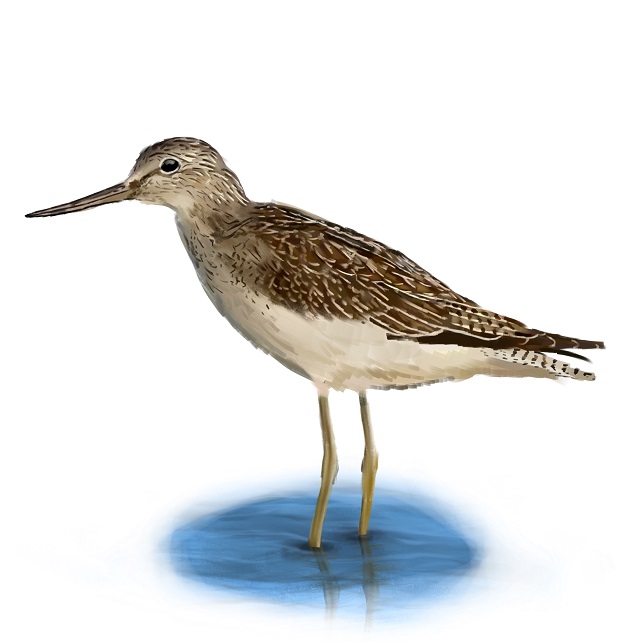
| Latin Name | Tringa nebularia |
| Diet | Mainly worms and snails, although fish will also be eaten. |
| Best time to see | January to December. |
| Distribution | Greenshanks can be seen anywhere on the UK coast during their migrations, but only breed in north-west Scotland. |
| Habitat | Boggy moorland and peat habitats are preferred for nesting, while coastal estuaries and wetlands are favoured feeding grounds. |
| Migrant/Resident | Male greenshanks perform elaborate display flights over their breeding grounds, often tumbling in the air while singing exuberantly. |
| Interesting fact | Diving to depths of up to 6 metres, these birds have an 80% success rate when it comes to finding food. |
Kingfishers
Common kingfisher
The kingfisher is one of the most colourful birds in the UK, with plumage that is a mixture of orange, white and electric blue. It has a long, sharp beak and pink feet. Measuring just 16 cm in length, it has a 25 cm wingspan.

| Latin Name | Alcedo atthis |
| Diet | Mainly small fish such as minnows, along with the occasional insect. |
| Best time to see | December to February. |
| Distribution | Found largely in southern regions of the UK, with some populations in central Scotland and Northern Ireland. |
| Habitat | Kingfishers are birds of slow-moving waterways such as lakes, canals and rivers. They often move closer to the coast during winter. |
| Migrant/Resident | Resident breeder. |
| Interesting fact | A kingfisher’s beak is designed to be as aerodynamic as possible, allowing it to cut through air and water with maximum speed. It works so efficiently that many Japanese bullet trains are designed to mimic it. |
Raptors
White-tailed eagle
As the largest bird of prey in the UK, the white-tailed eagle measures 85 cm in length, with a 2.2 m wingspan. It has brown plumage, with a pale head and distinctive white tail feathers.
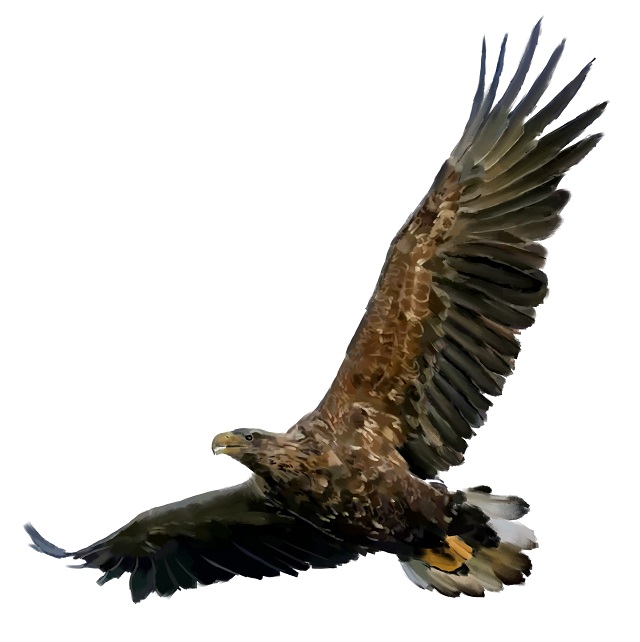
| Latin Name | Haliaeetus albicilla |
| Diet | Fish is preferred, although mammals, birds and carrion will also be eaten. |
| Best time to see | December to February. |
| Distribution | The species was confined to the north-west of Scotland in previous years, although a breeding program has now introduced some birds to eastern Scotland. |
| Habitat | White-tailed eagles can be found in lowland coastal habitats such as estuaries and marshes. |
| Migrant/Resident | Resident breeder. |
| Interesting fact | White-tailed eagles often reuse the same nests time and again, with some being occupied for more than 100 years, by multiple generations. |
Western marsh harrier
Female western marsh harriers have chocolate-brown plumage and pale heads, while males are lighter in colour and have grey wings. Both sexes have long tails and average 51 cm in length, with 1.2 m wingspans.
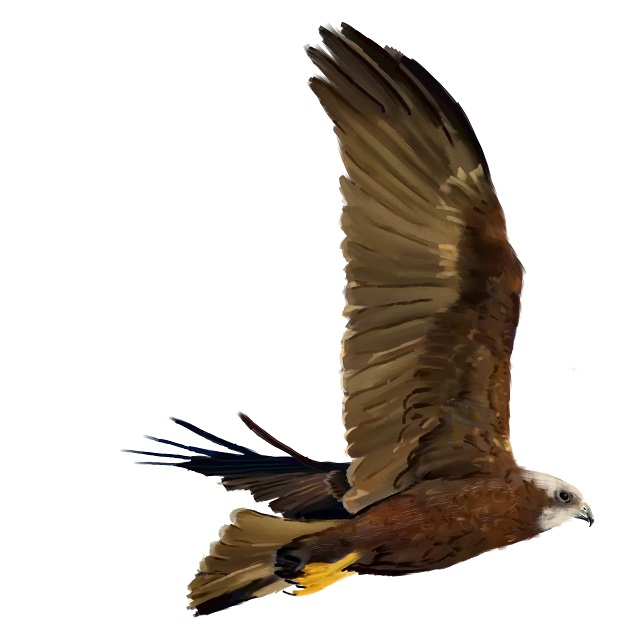
| Latin Name | Circus aeruginosus |
| Diet | Predominantly small mammals and birds. |
| Best time to see | April to August. |
| Distribution | Mainly found in south-east England, with small populations in Scotland and north-west England. |
| Habitat | Marsh harriers are usually seen over marshland and reedbeds in coastal areas. |
| Migrant/Resident | Resident breeder. |
| Interesting fact | After relentless persecution, just one female marsh harrier remained in the UK in 1971. The species has since bounced back and has increased in number in recent years, with more than 400 breeding pairs. |
Falcons
Peregrine falcon
The peregrine falcon is the largest of the UK’s falcons, measuring 45 cm in length on average, with a 1.2 m wingspan. It has slate-grey plumage above and white feathers with grey barring below.
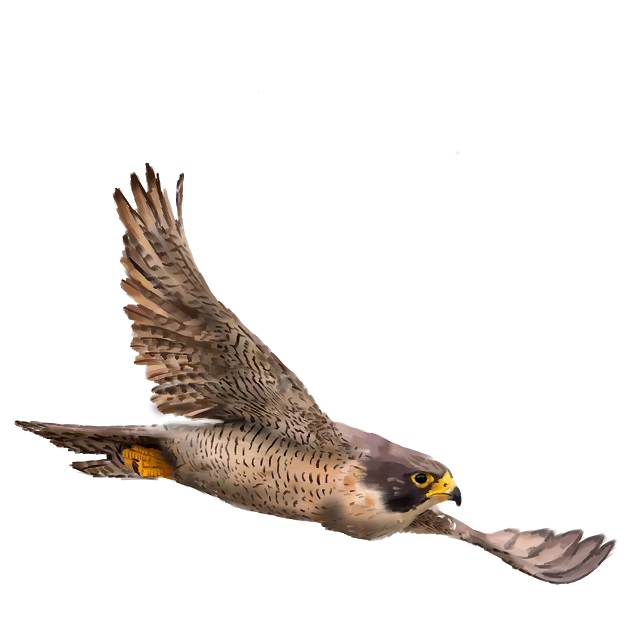
| Latin Name | Falco peregrinus |
| Diet | Medium-sized birds are the most common food taken. |
| Best time to see | March to June. |
| Distribution | Can be found almost anywhere in the UK, apart from higher altitudes in the Scottish Highlands. |
| Habitat | Peregrine falcons are often seen around rocky seacliffs in spring and summer, moving further inland during winter. |
| Migrant/Resident | Resident breeder. |
| Interesting fact | Peregrines are the fastest animals on the planet, capable of reaching speeds in excess of 200 mph as they dive in pursuit of prey. |
Passerines
Reed Bunting
Reed buntings have streaky brown plumage, although males have a darker colouration and a black head. They measure 16 cm in length, with 24 cm wingspans.
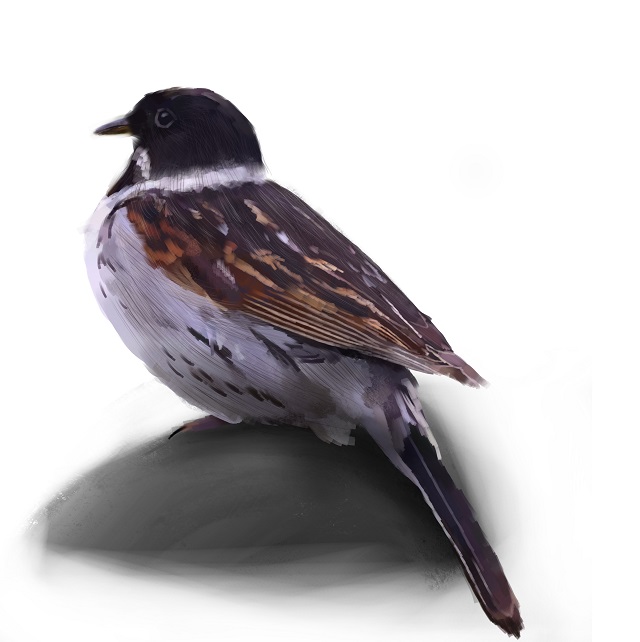
| Latin Name | Emberiza schoeniclus |
| Diet | Mostly seeds, supplemented by insects. |
| Best time to see | May to July. |
| Distribution | Common throughout much of the UK, with higher numbers in the south. |
| Habitat | Reed buntings are most often seen around farmland and wetland areas, although they use a wide variety of habitats and will even visit gardens. |
| Migrant/Resident | Resident breeder. |
| Interesting fact | Reed buntings sometimes roost in very large numbers, often in wetland habitats, grouping together overnight so that they can better detect predators. |
Eurasian reed warbler
The Eurasian reed warbler is a small bird that measures 13 cm in length, with a 19 cm wingspan. Its plumage is pale brown above and lighter below, with yellowish areas around the wings.
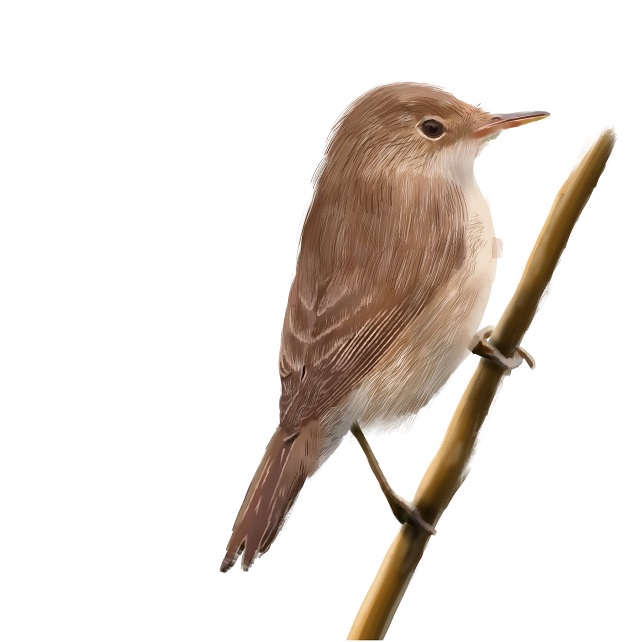
| Latin Name | Acrocephalus scirpaceus |
| Diet | Mainly feeds on insects, although berries will be eaten in autumn. |
| Best time to see | May to September. |
| Distribution | Eurasian reed warblers are mostly found in southern England and coastal regions in Wales. |
| Habitat | Primarily reedbeds in wetland areas. |
| Migrant/Resident | Breeding summer visitor. |
| Interesting fact | Eurasian reed warblers often fall foul to the brood parasitism of cuckoos – who remove the reed warbler’s eggs from the nest and replace them with one of their own. |
Red-billed chough
The red-billed chough gets its name from its bright red bill, with legs of the same colour. Its plumage is uniformly black. It’s a medium-sized bird, measuring 39 cm in length, with an 82 cm wingspan.
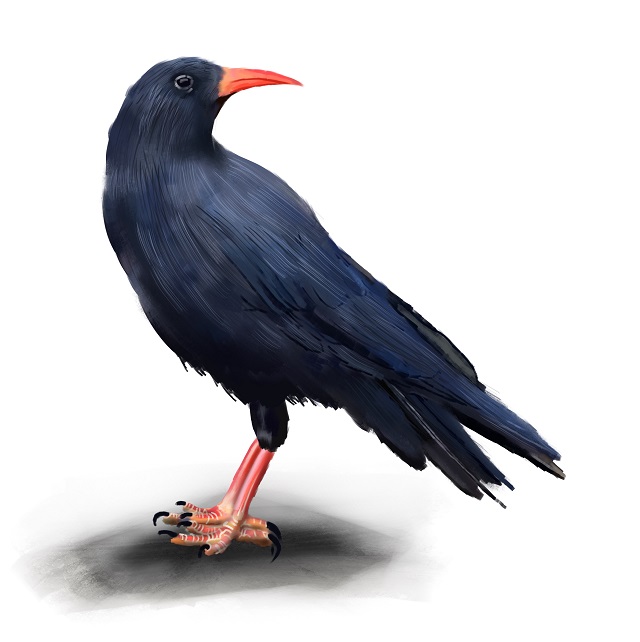
| Latin Name | Pyrrhocorax pyrrhocorax |
| Diet | Invertebrates such as spiders are consumed most often. |
| Best time to see | March to June. |
| Distribution | Red-billed choughs are confined to western coasts, with the largest numbers found in Wales. Can also be found in Cornwall and western Scotland. |
| Habitat | Rocky coasts are their preferred habitat, although they can also be seen on grassland. |
| Migrant/Resident | Resident breeder. |
| Interesting fact | It was once believed that choughs would steal matches from houses and set fire to thatched roofs. This belief possibly stemmed from the birds’ bright red features. |
European stonechat
The European Stonechat is a small bird with brown upper parts and a reddish breast. Males have black heads with white necks. Measuring 12 cm in length, they have a 20 cm wingspan.
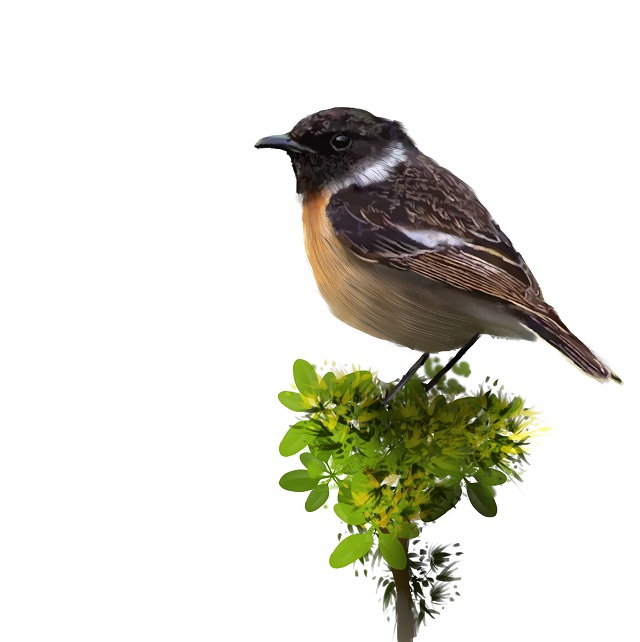
| Latin Name | Saxicola rubicola |
| Diet | Mainly invertebrates, seeds and the occasional berry. |
| Best time to see | March to June. |
| Distribution | Widespread in the UK, with the greatest numbers found in southern England and Wales. |
| Habitat | Stonechats are often seen in areas of heathland and grassland, especially near the coast. |
| Migrant/Resident | Resident breeder. |
| Interesting fact | Stonechats are so-called because their loud calls sound just like two stones being tapped together. They often do this while perched near the tops of trees. |
Illustrations ©GBC
References and more info:
Animal Diversity Web – https://animaldiversity.org/
Arnott, W. (1977). Swan Songs. Greece & Rome, 24(2), 149-153. Retrieved March 1, 2021, from http://www.jstor.org/stable/642700
Birds of Britain – https://birdsofbritain.co.uk/index.asp
National Trust – https://www.nationaltrust.org.uk/blakeney-national-nature-reserve/features/seven-facts-you-didnt-know-about-little-terns
Oceanwide Expeditions – https://oceanwide-expeditions.com/to-do/wildlife/storm-petrel
RSPB – https://www.rspb.org.uk/
ScienceDirect – https://www.sciencedirect.com/
Scottish Wildlife Trust – https://scottishwildlifetrust.org.uk/
The Wildlife Trusts – https://www.wildlifetrusts.org/
WhatBird – http://www.whatbird.com/
Illustrations: Juan Pablo Acosta Vazquez – Biologist/ scientific illustration and design
I’m a Mexican biologist and scientific illustrator with a passion for birds. With 5 years of experience in illustration and design, I bring a unique blend of skills, knowledge, and creativity to everything I do. Throughout my career, I have had the opportunity to work in many projects around the world, such as child books, scientific articles, animal field guides, posters, cartoons, and more. I have developed a strong foundation in scientific illustration of birds and have a proven track record of delivering results. Whether it’s physical or digital illustration, I thrive on challenging projects and am always seeking new ways to expand my skill set.
My approach to illustration and design in biology topics is centered around the importance of involving people outside the scientific world to better understand and take care of the planet and its inhabitants. I believe that all people should be involved in environmental knowledge and strive to make a positive impact through my work. I am known for my ability to make organism designs, which allow me to describe and illustrate the projects I’m in.
Outside of my professional life, I am passionate about music. Whether it’s playing saxophone, shakuhachi, guitar, and some other instruments, I find inspiration and balance in pursuing these interests. They fuel my creativity and provide a fresh perspective that I bring to my work.
